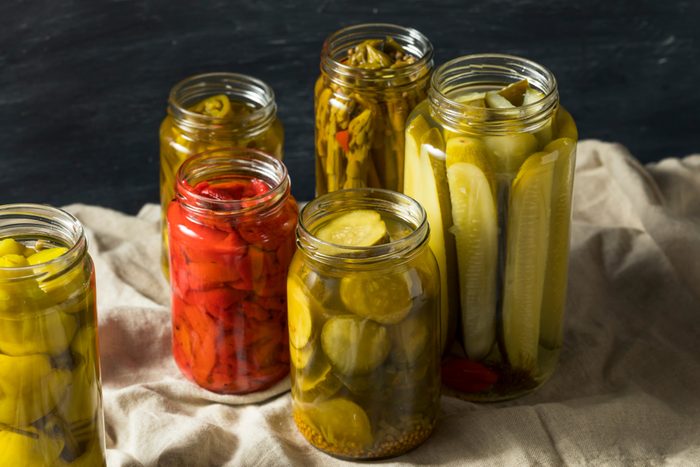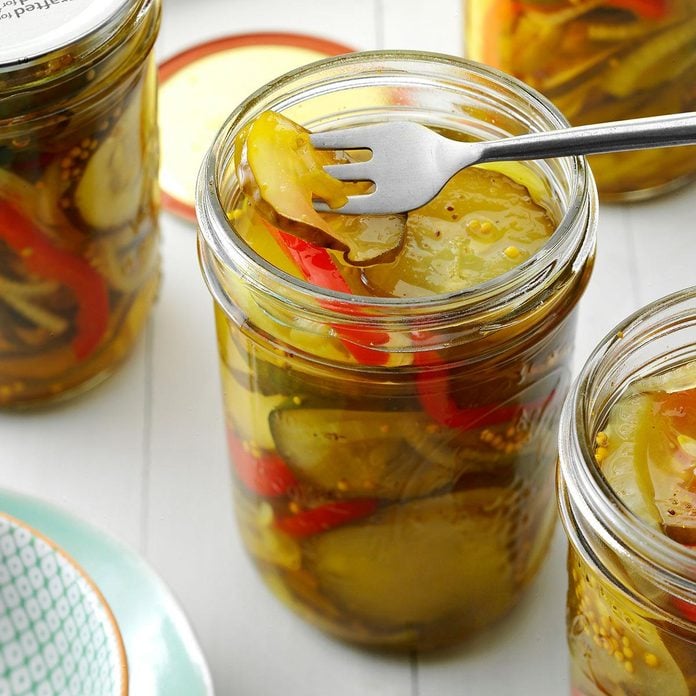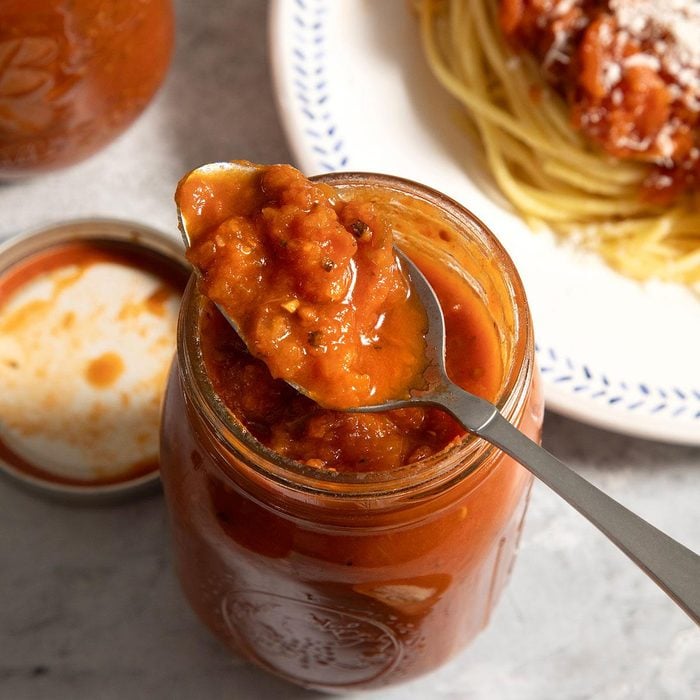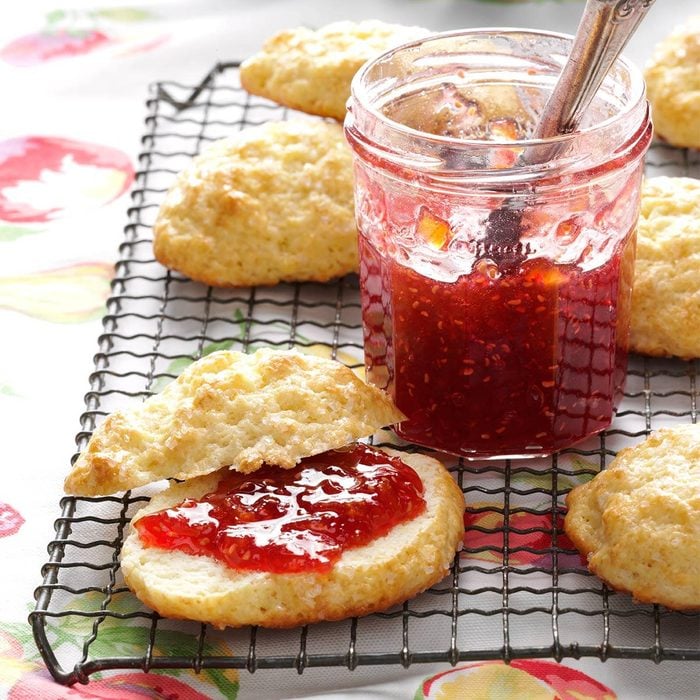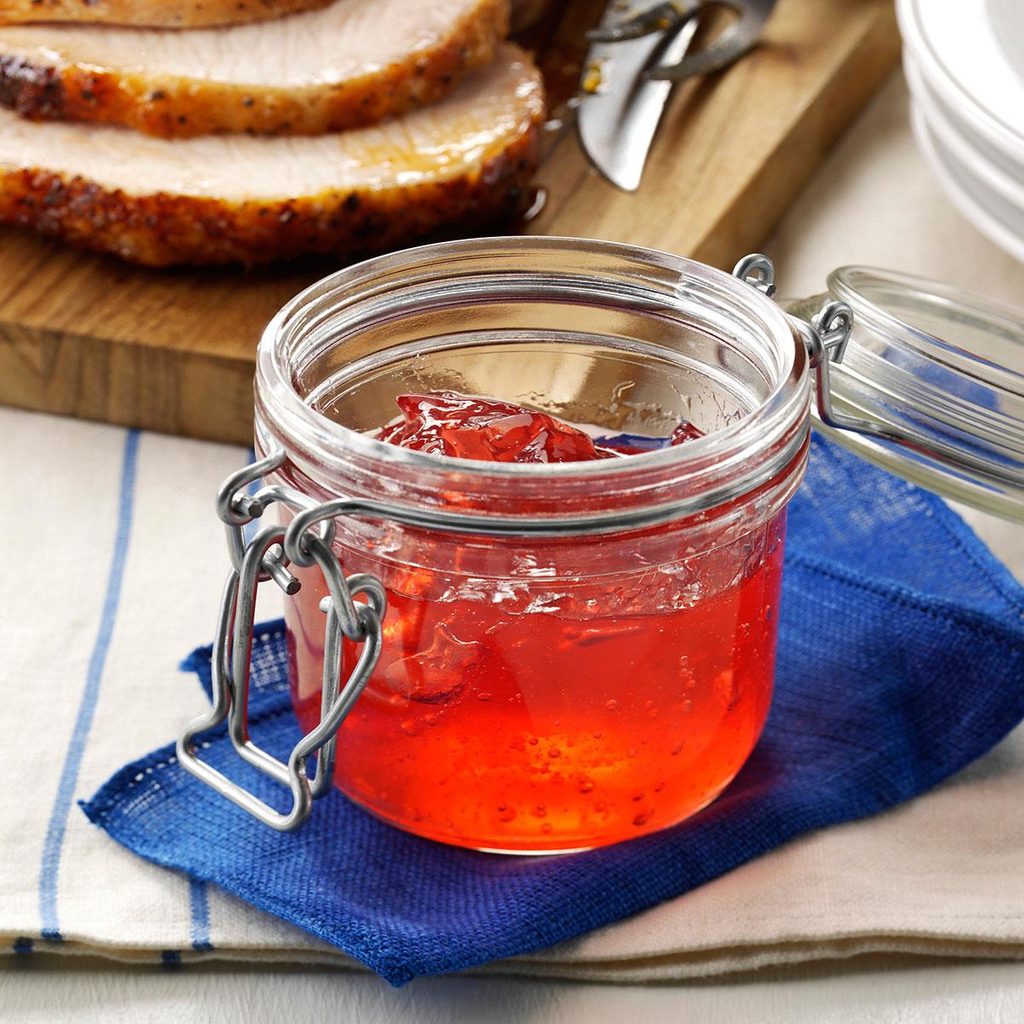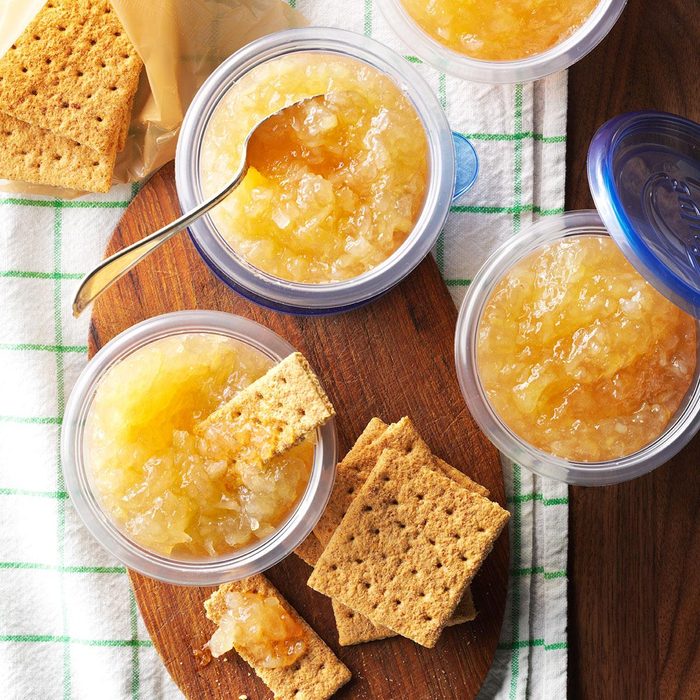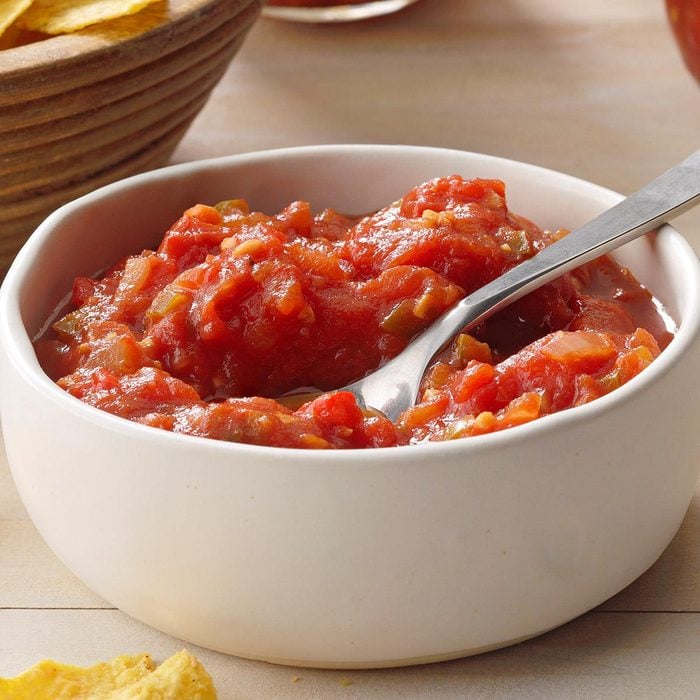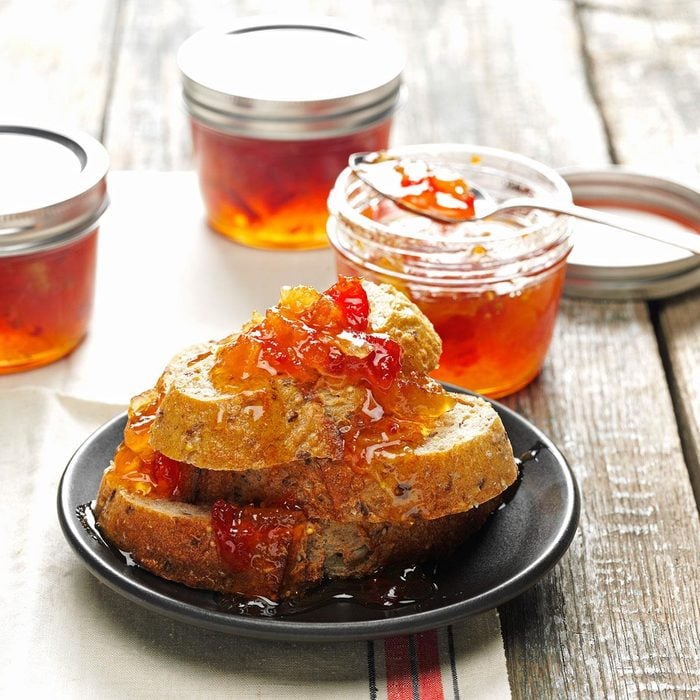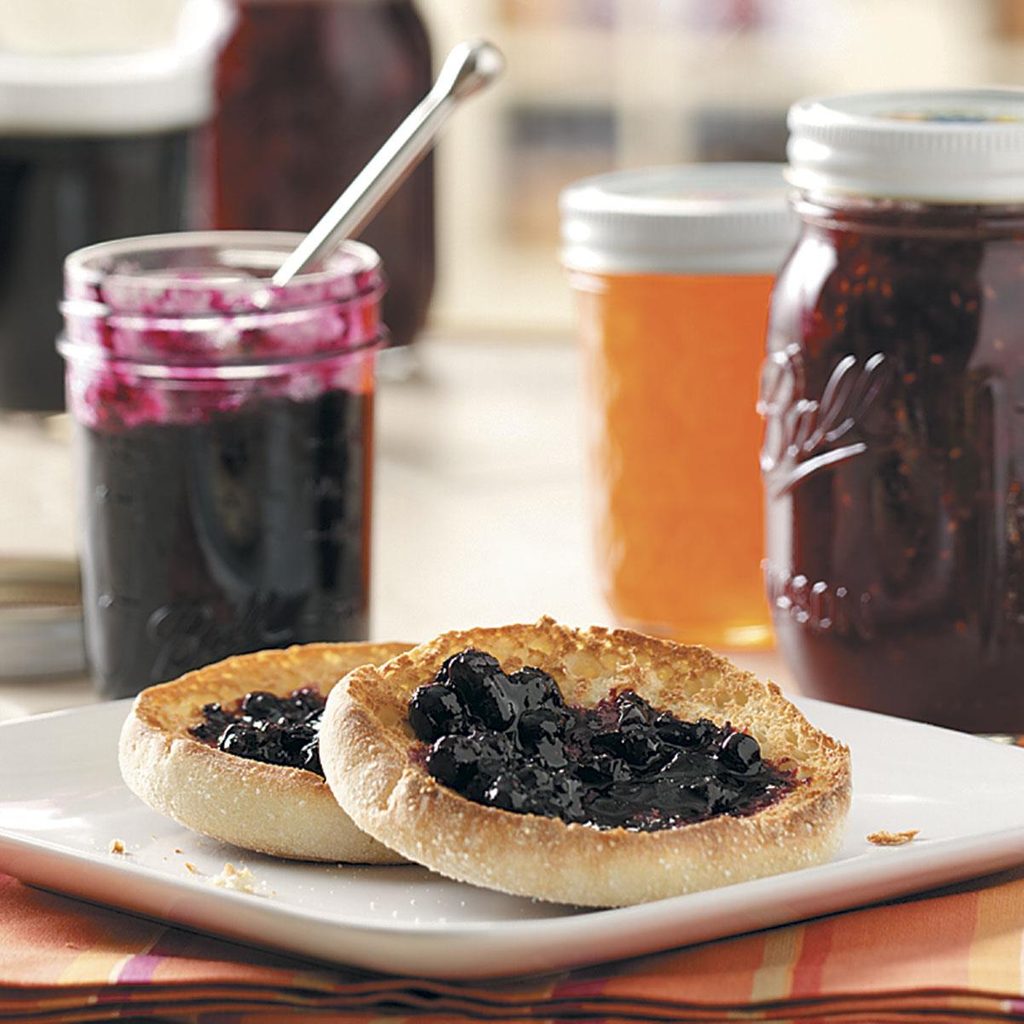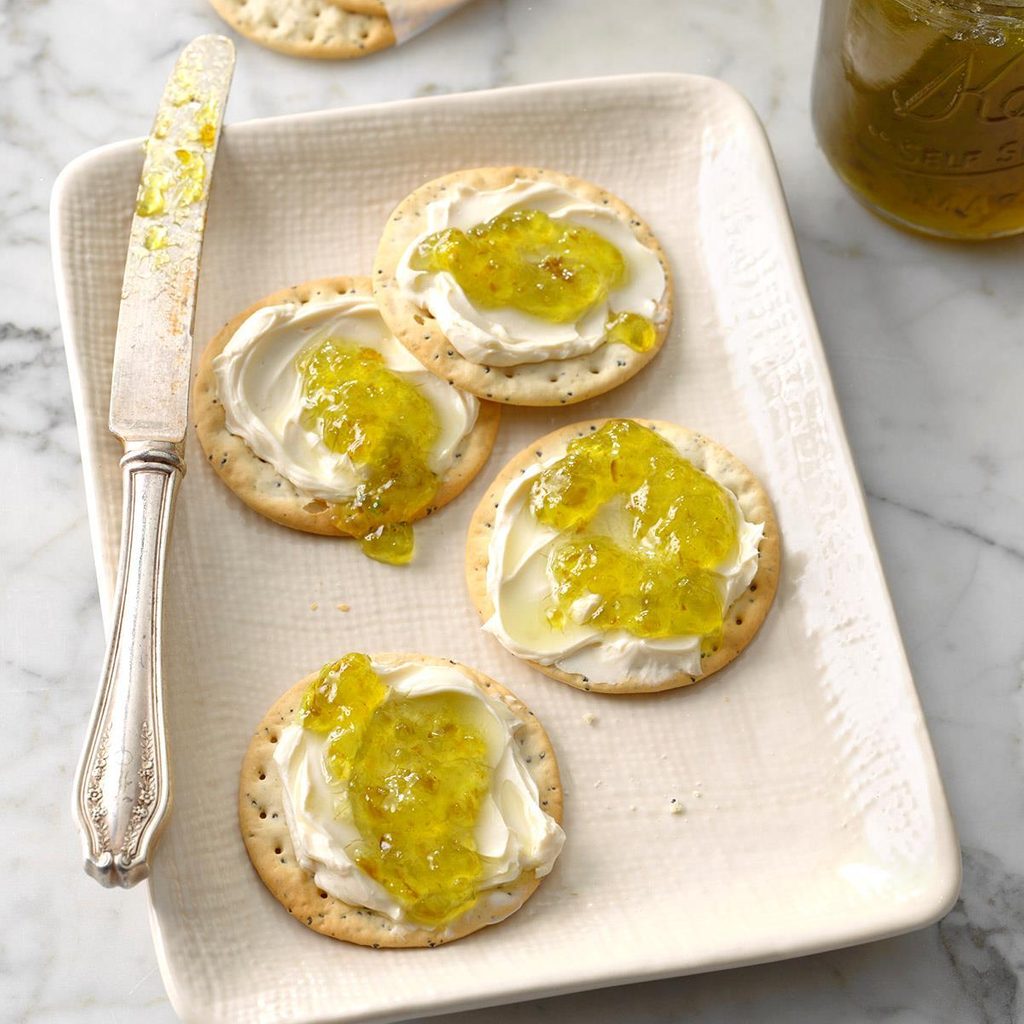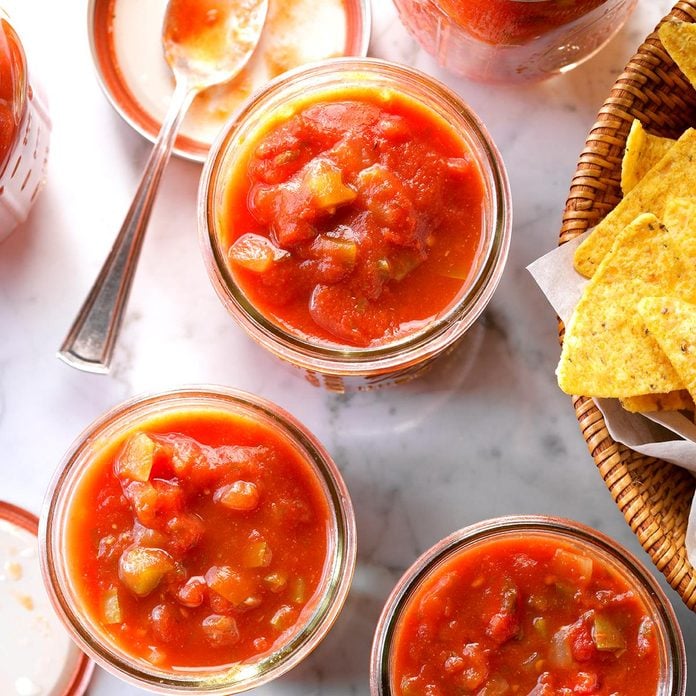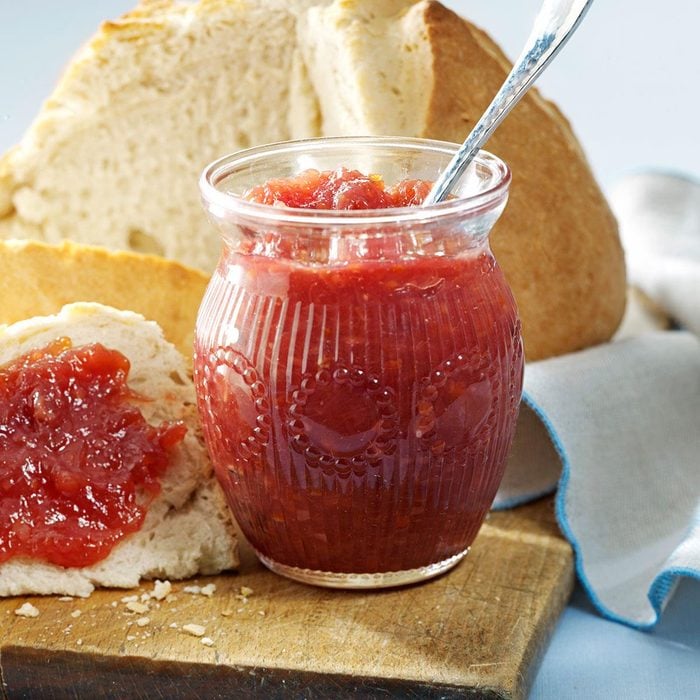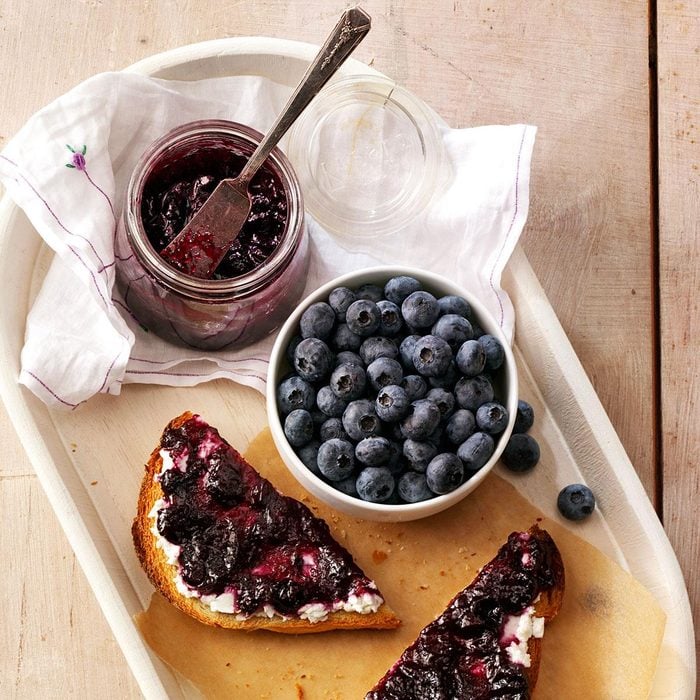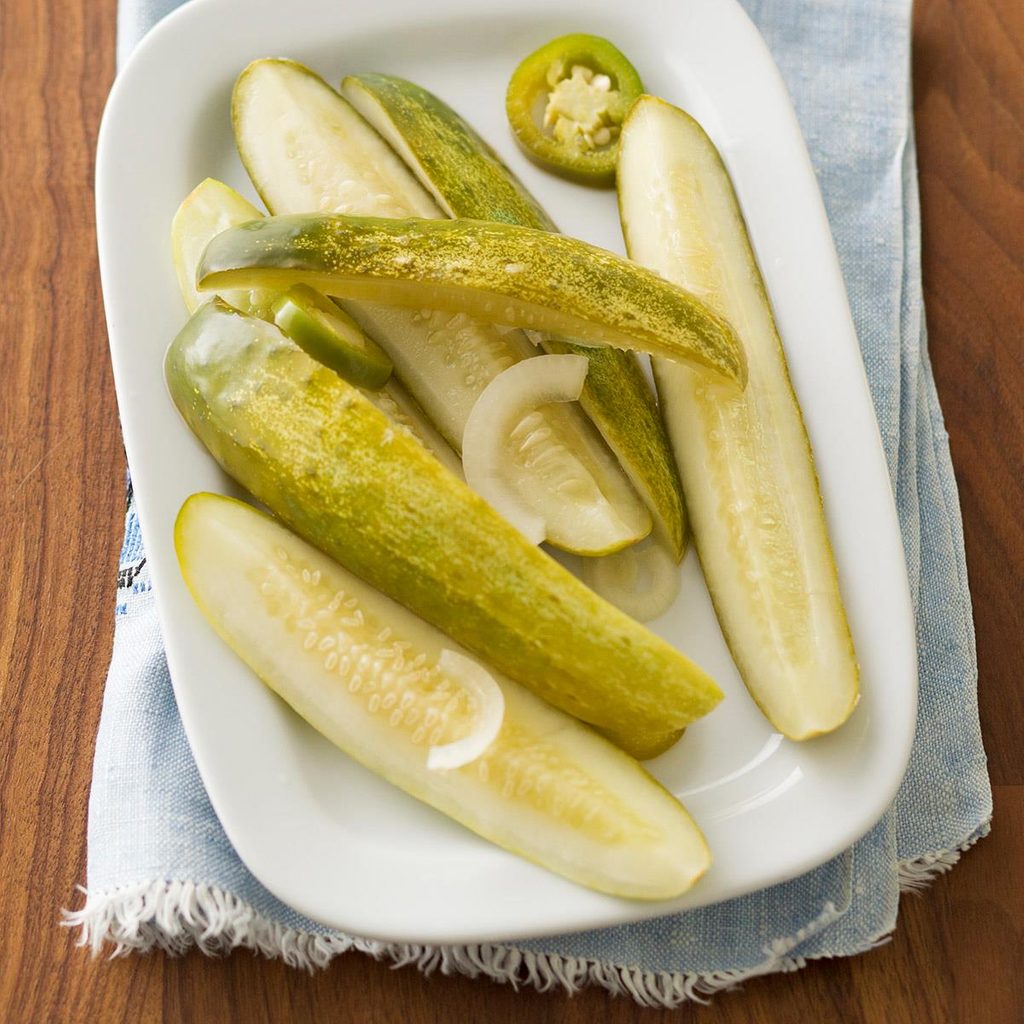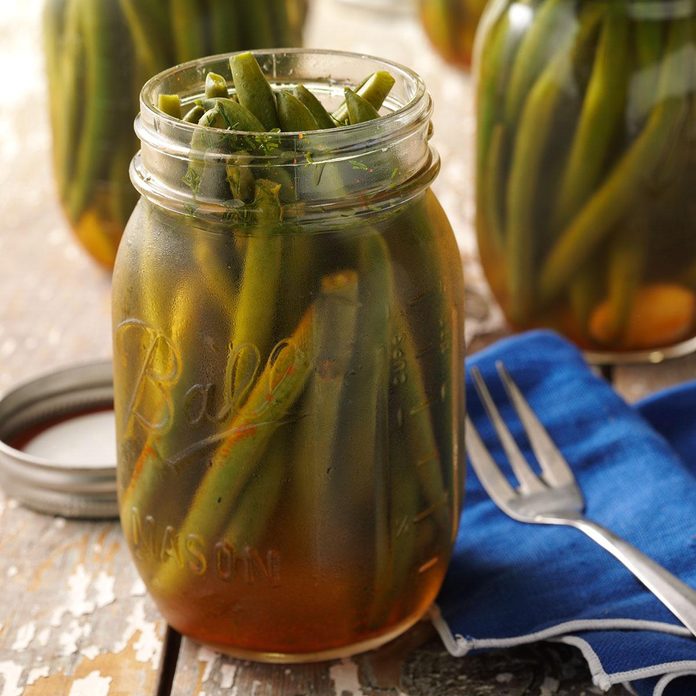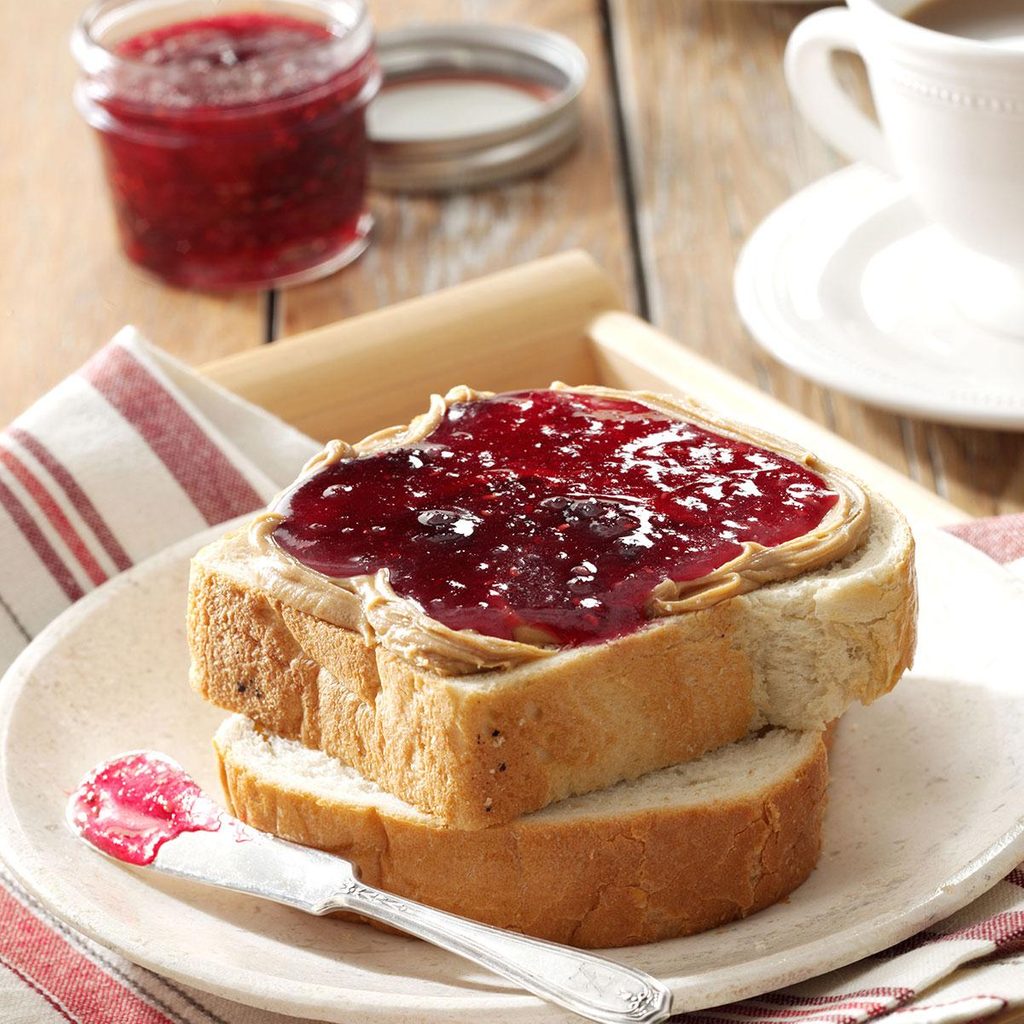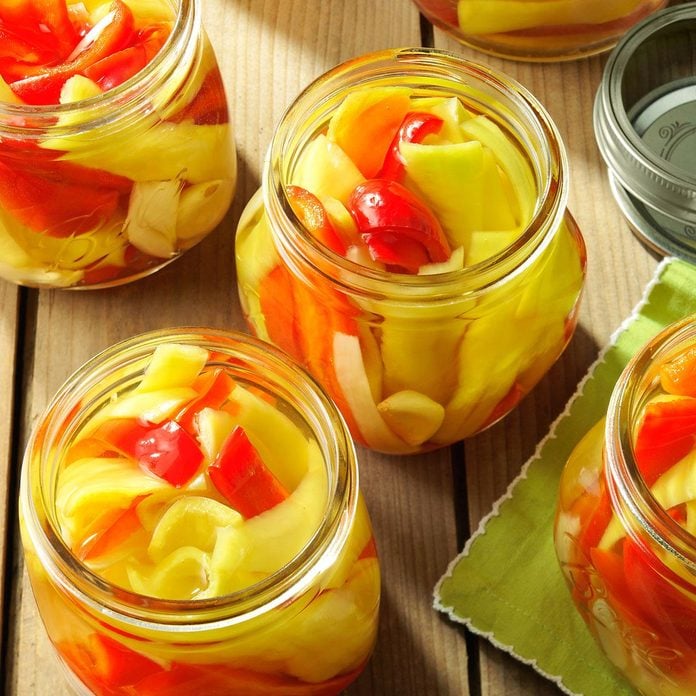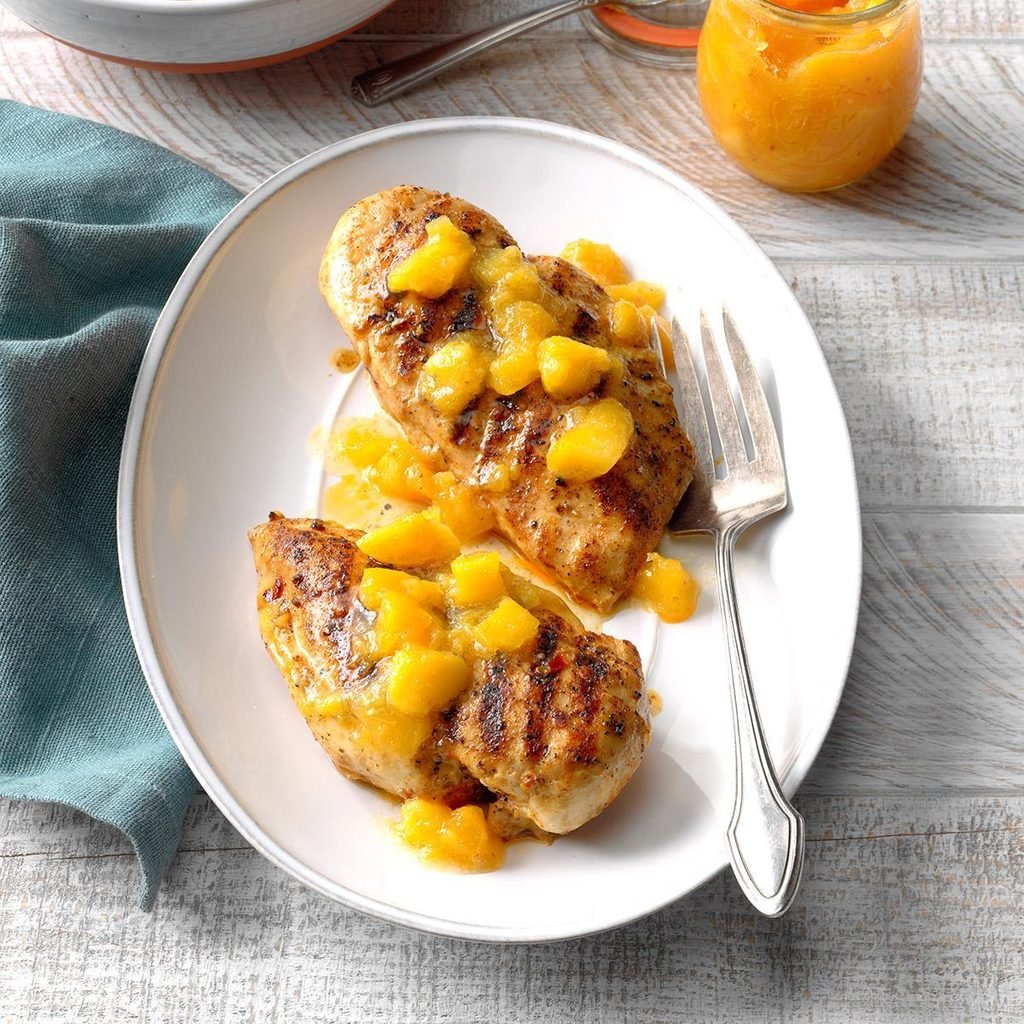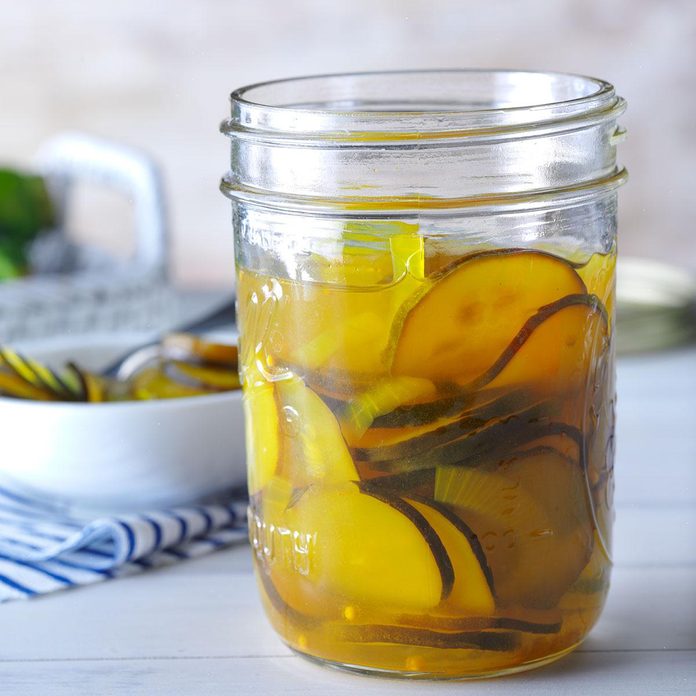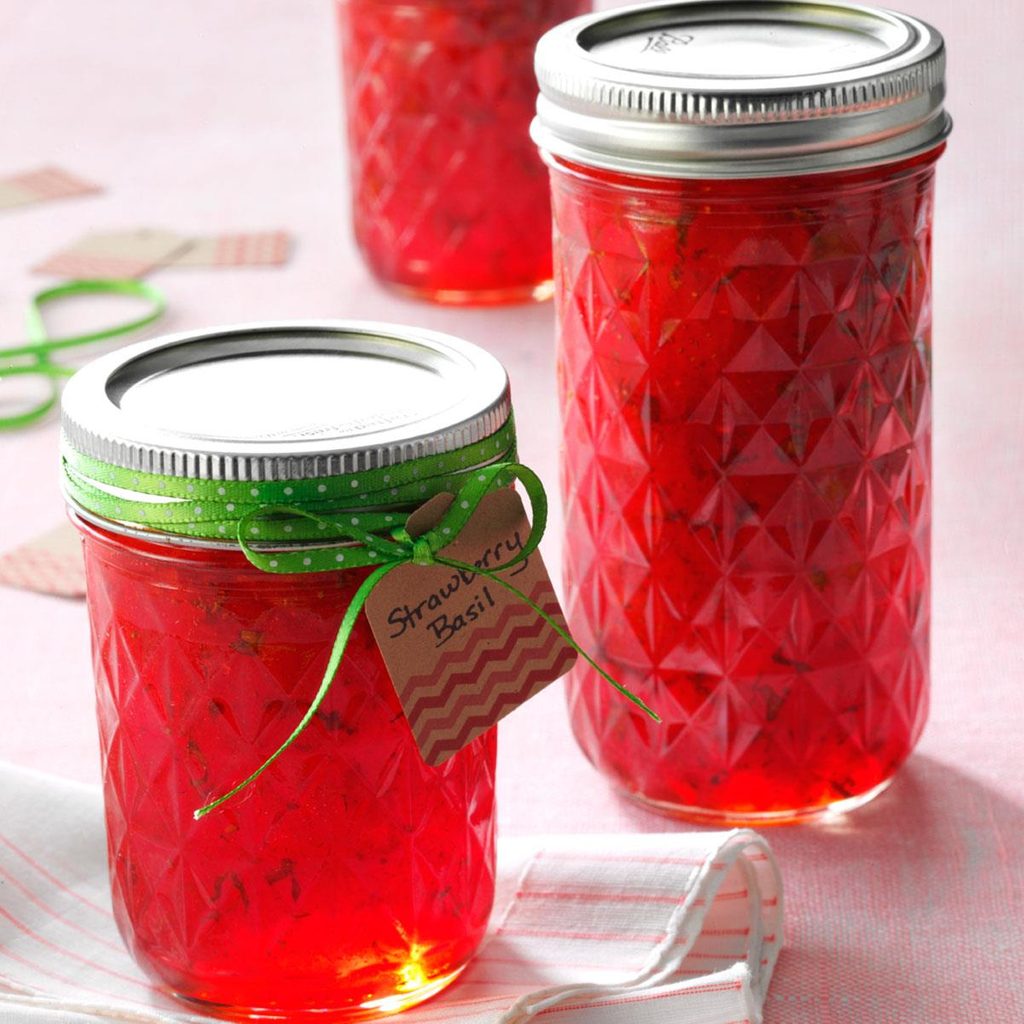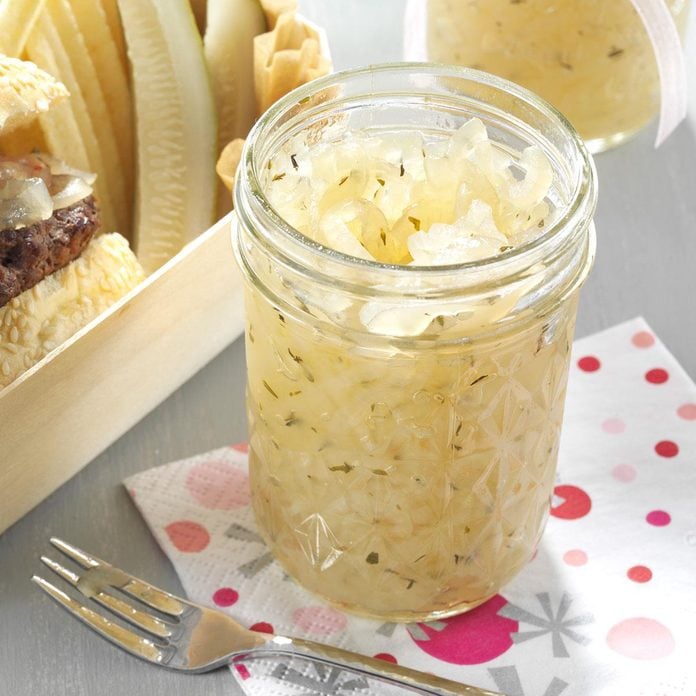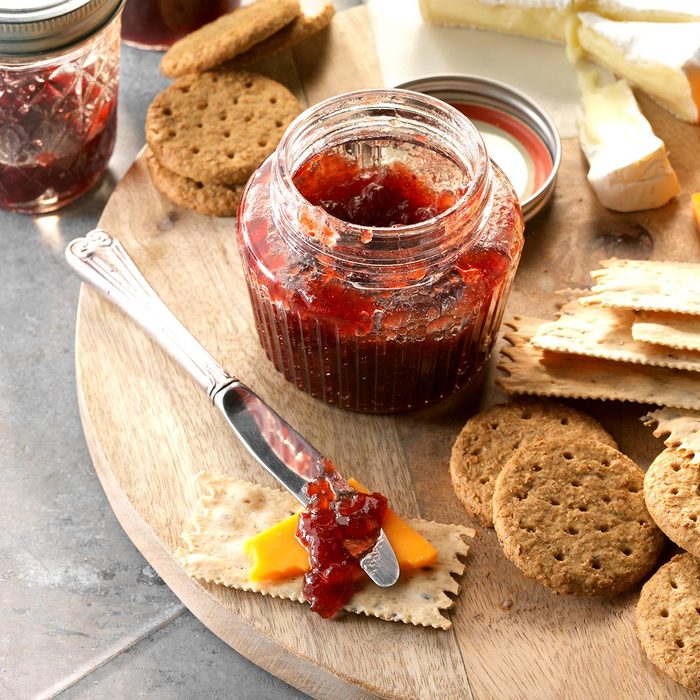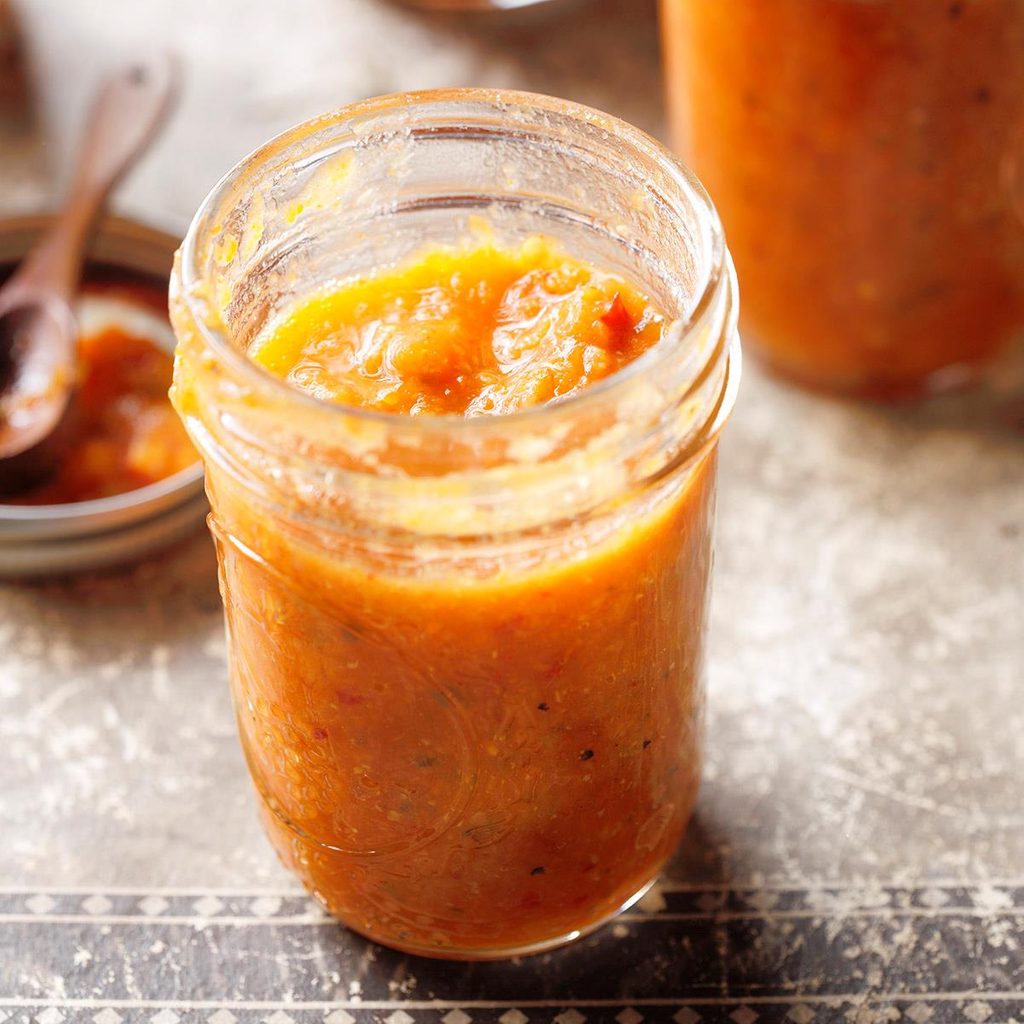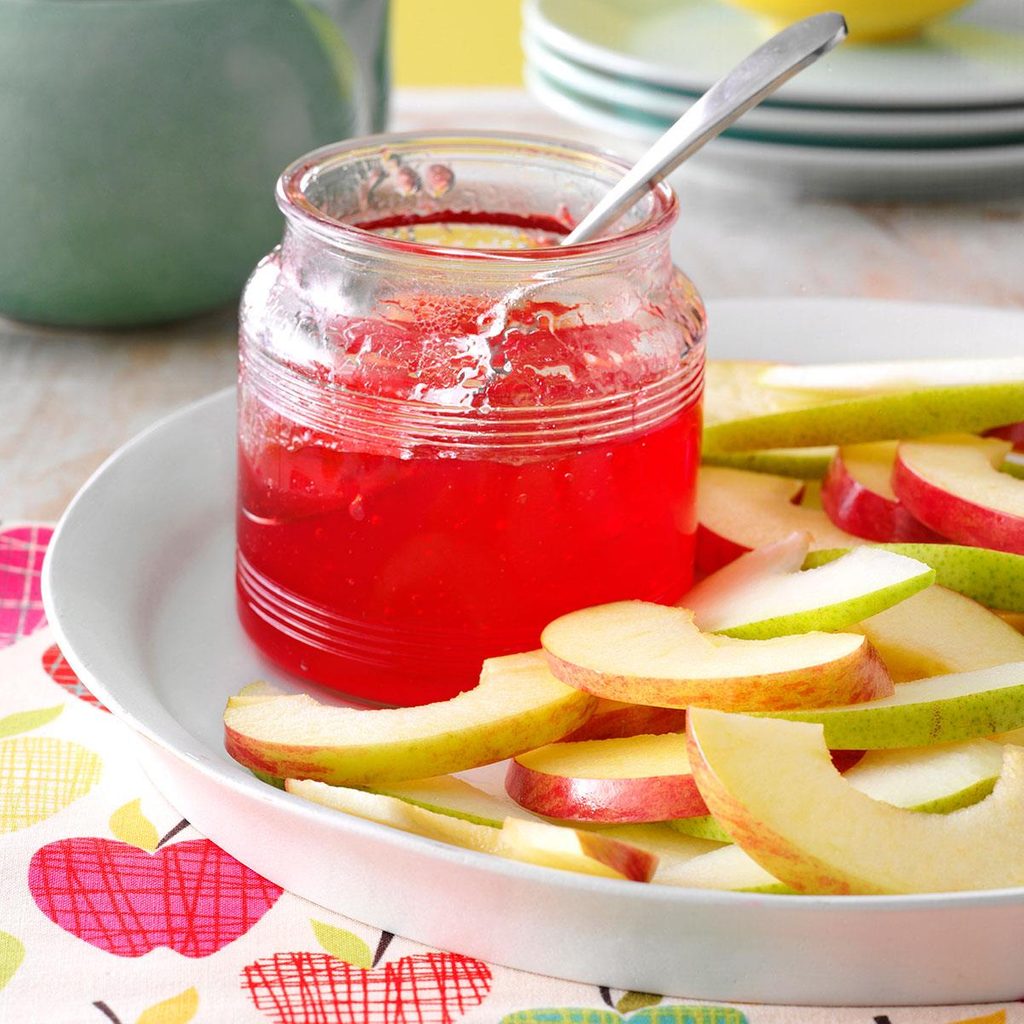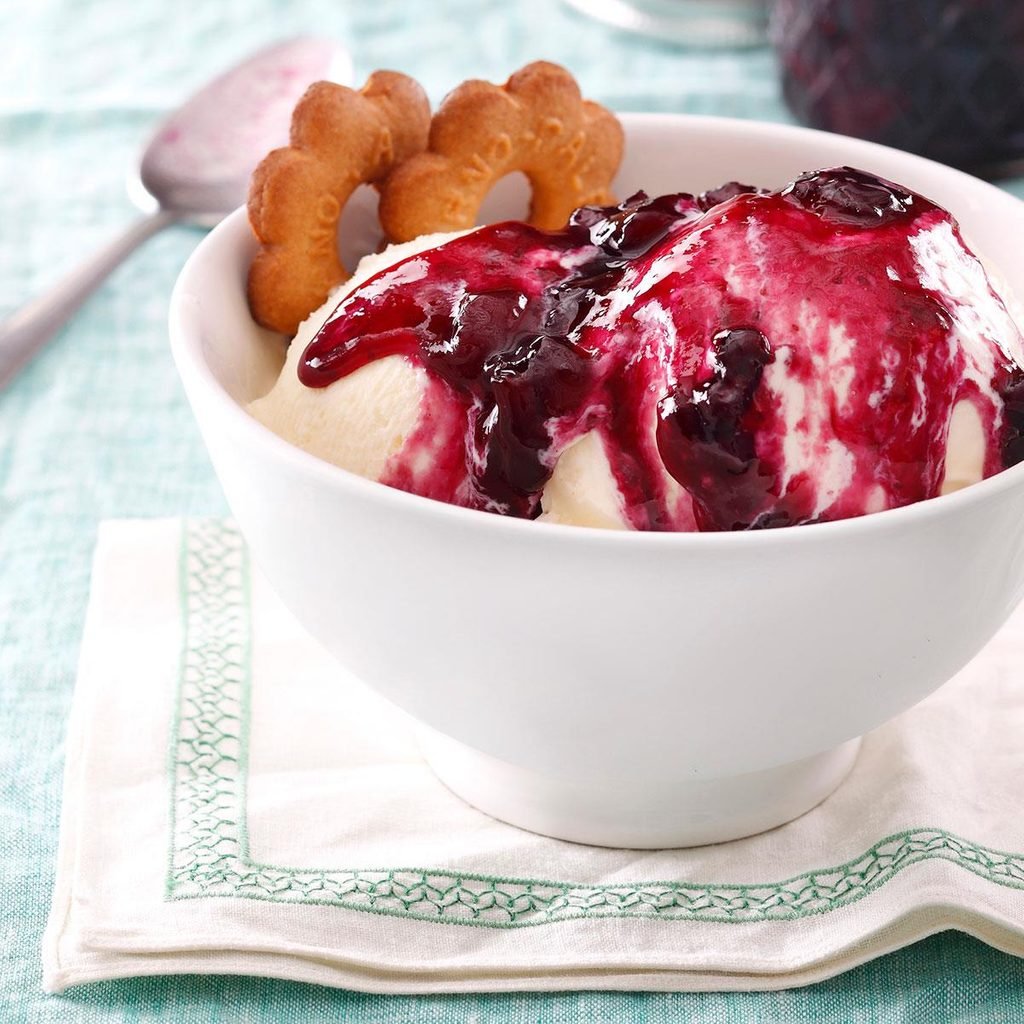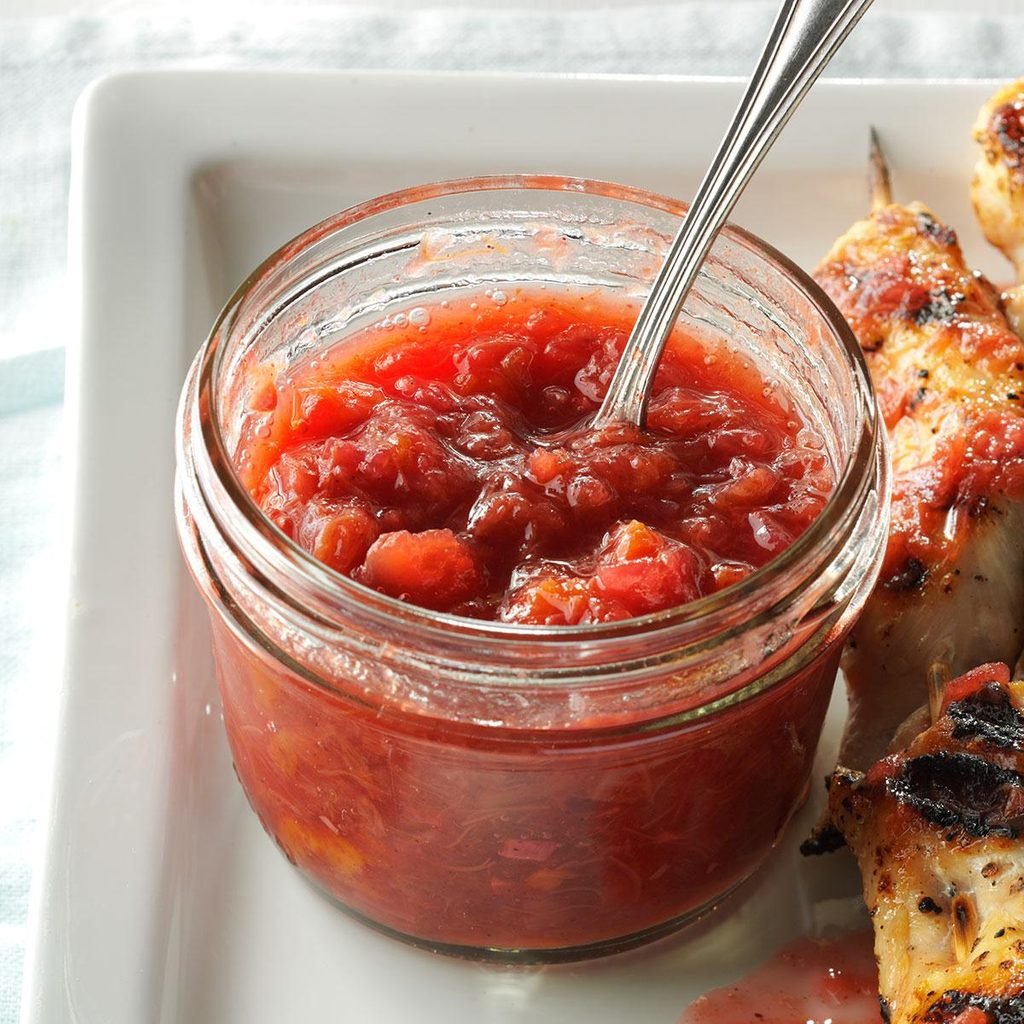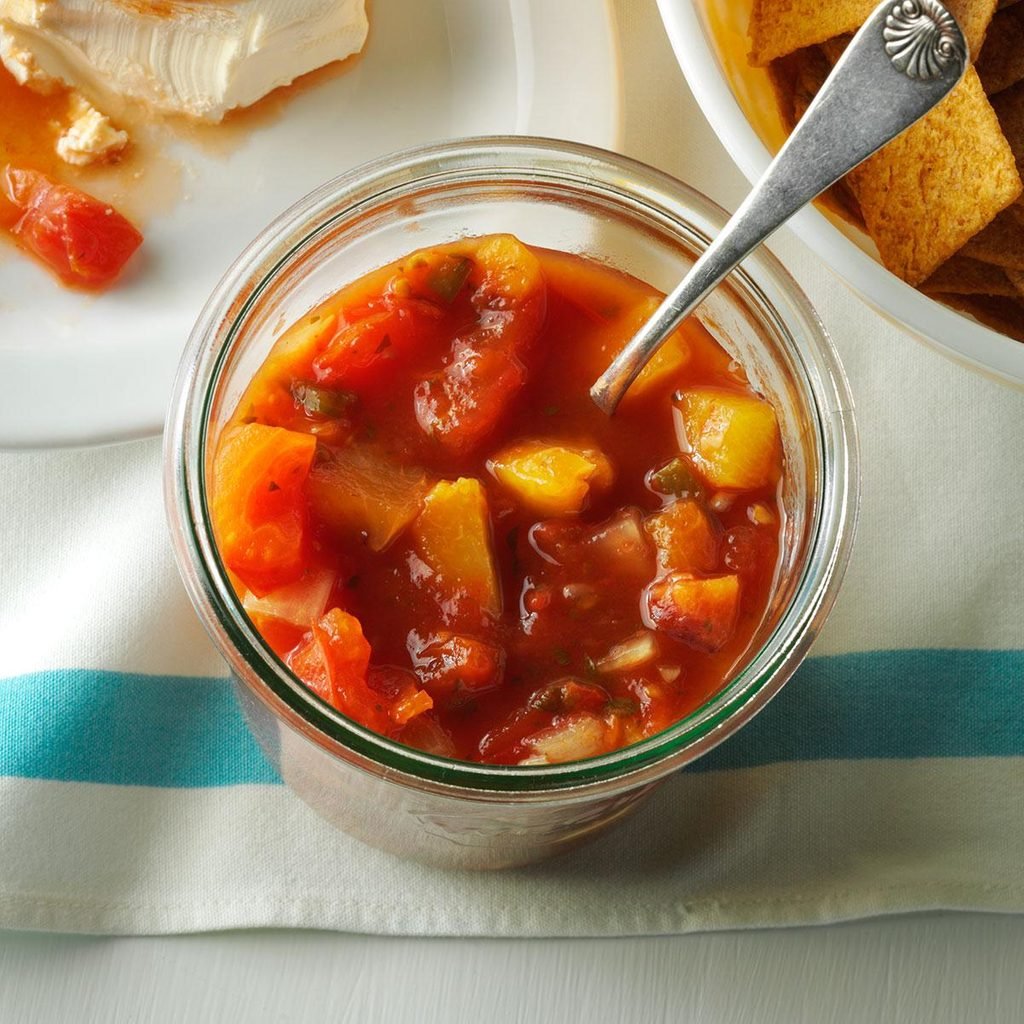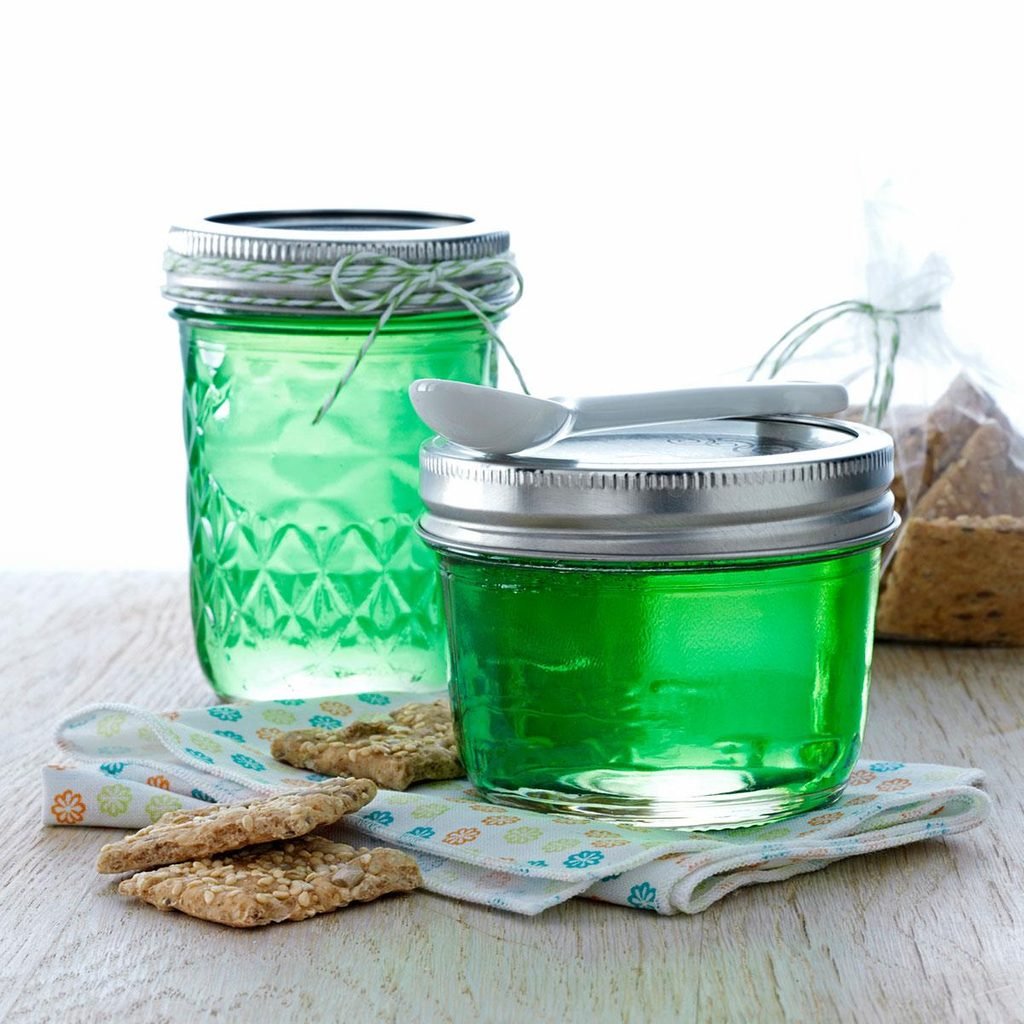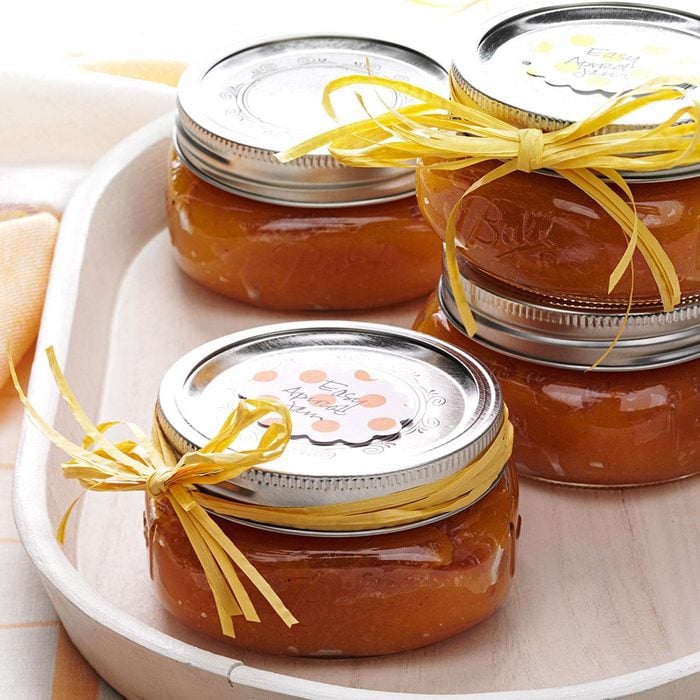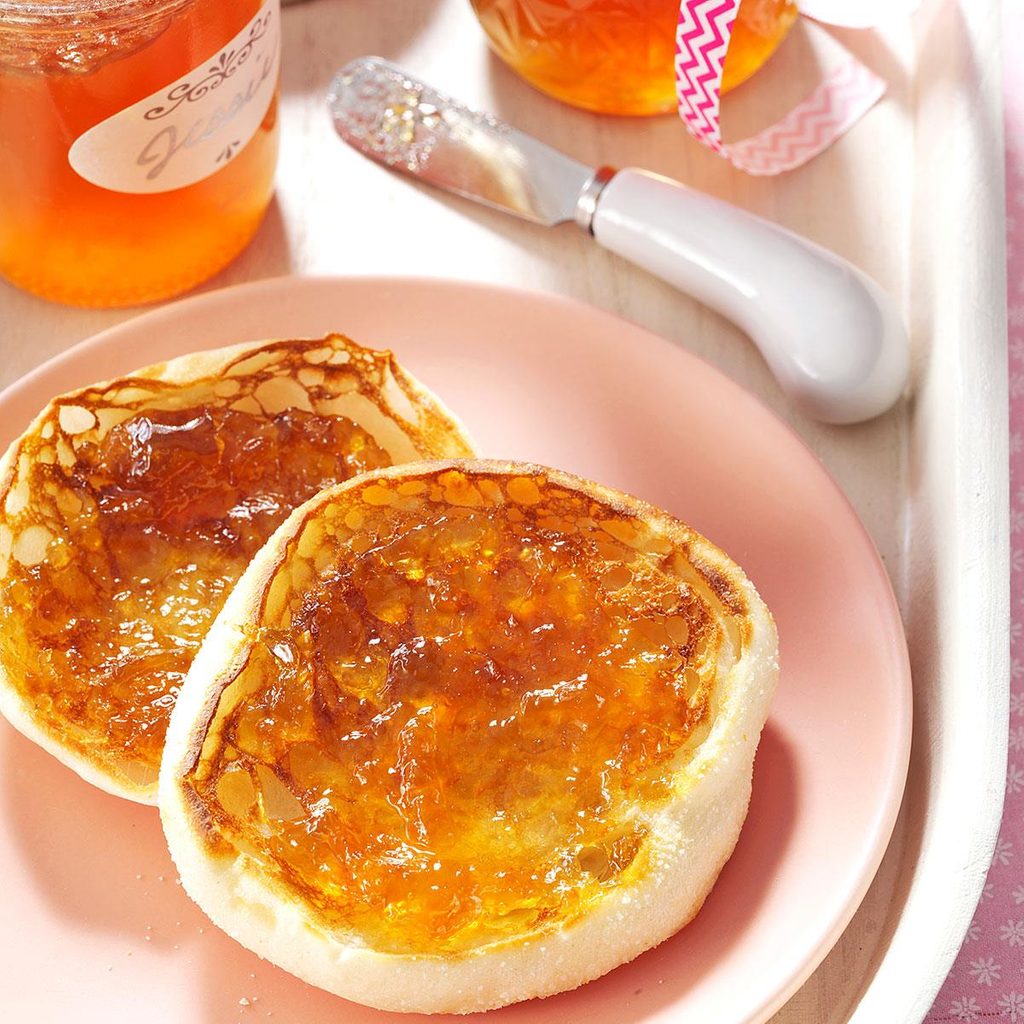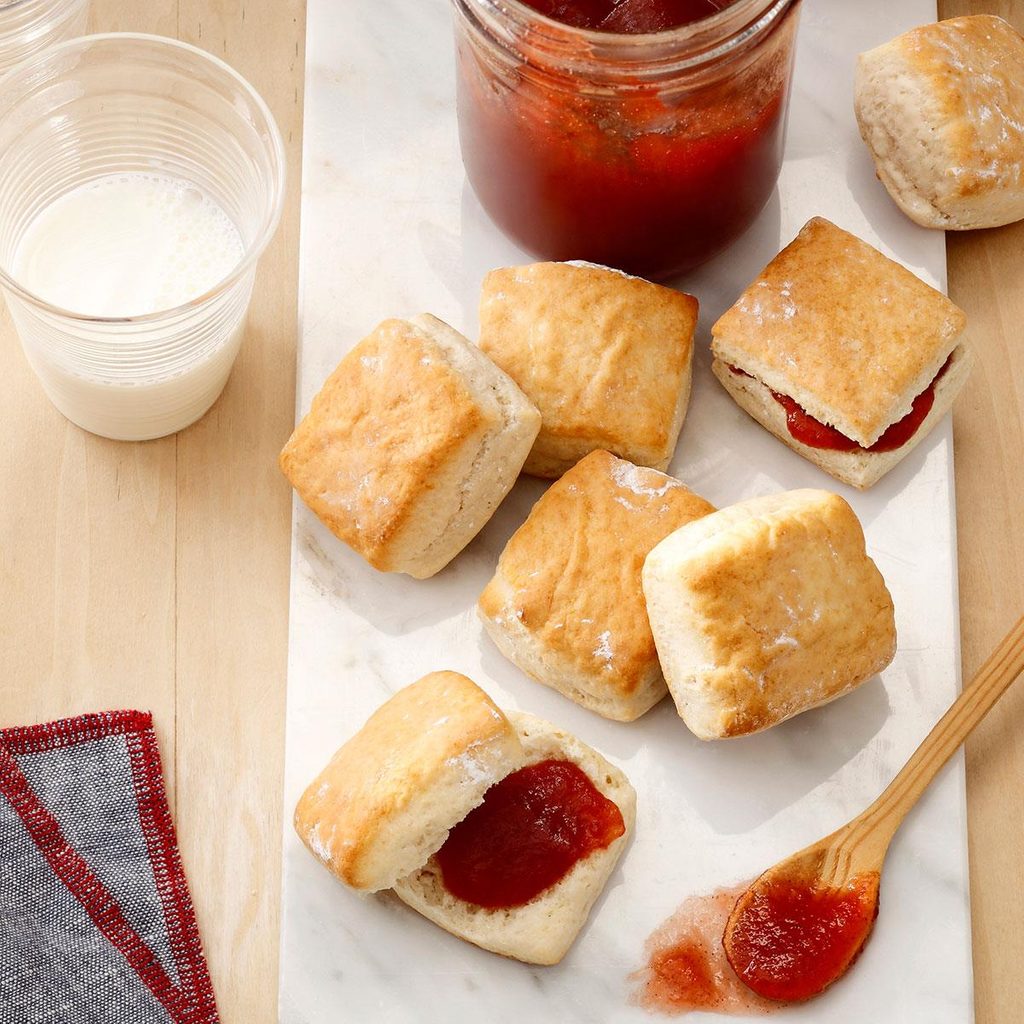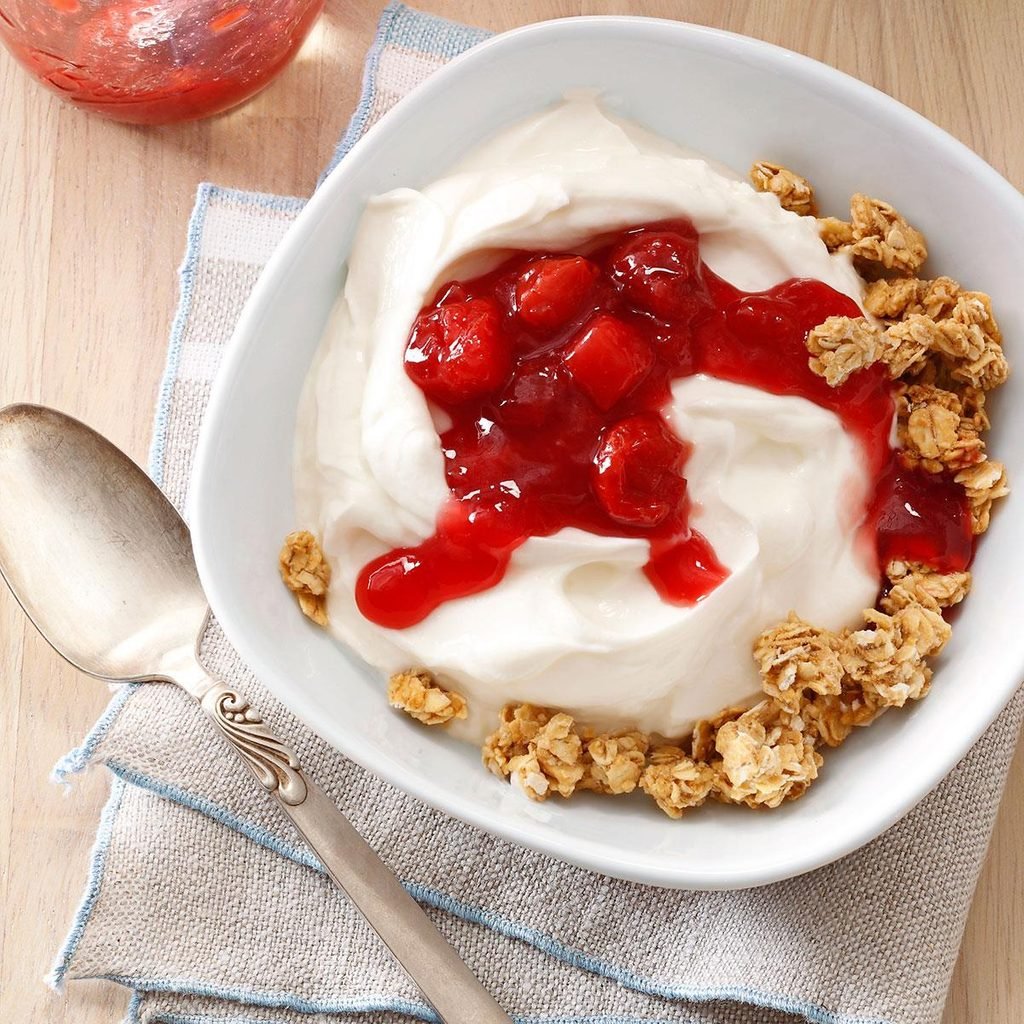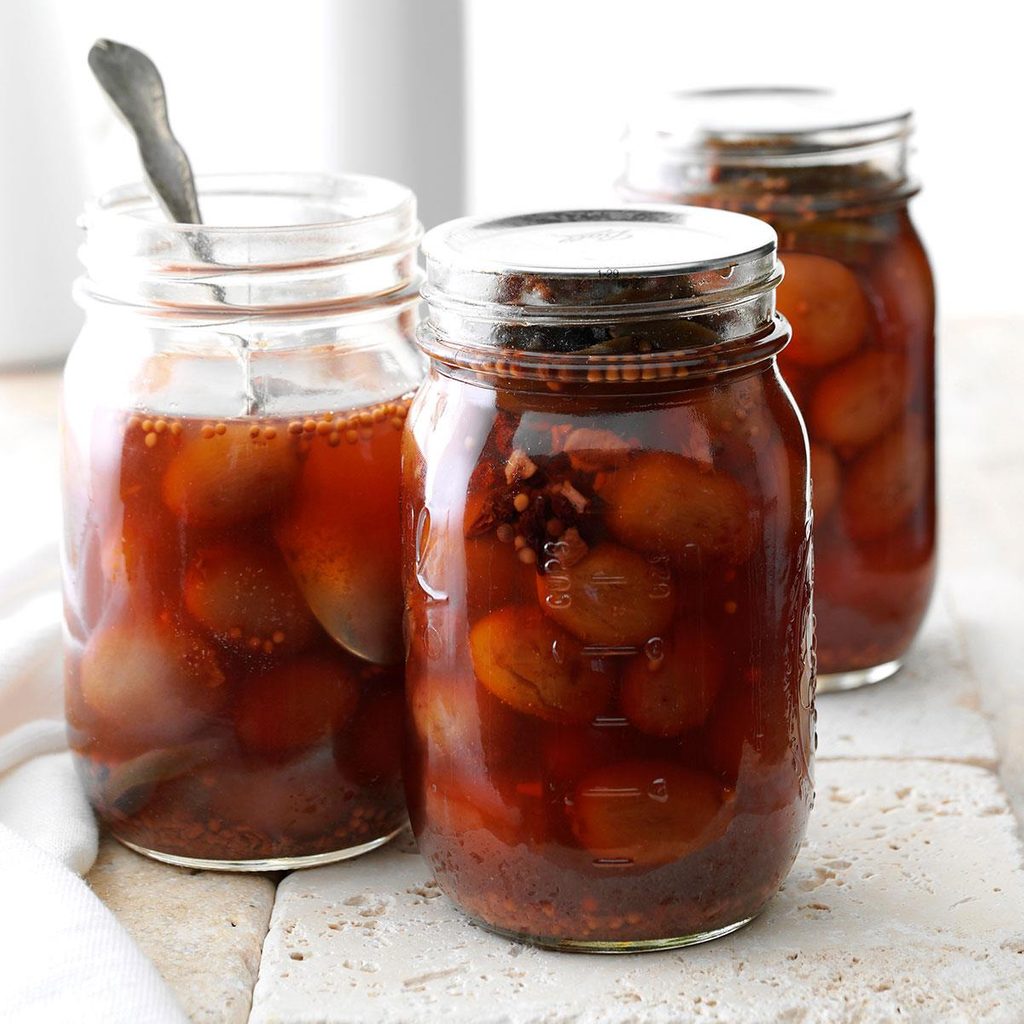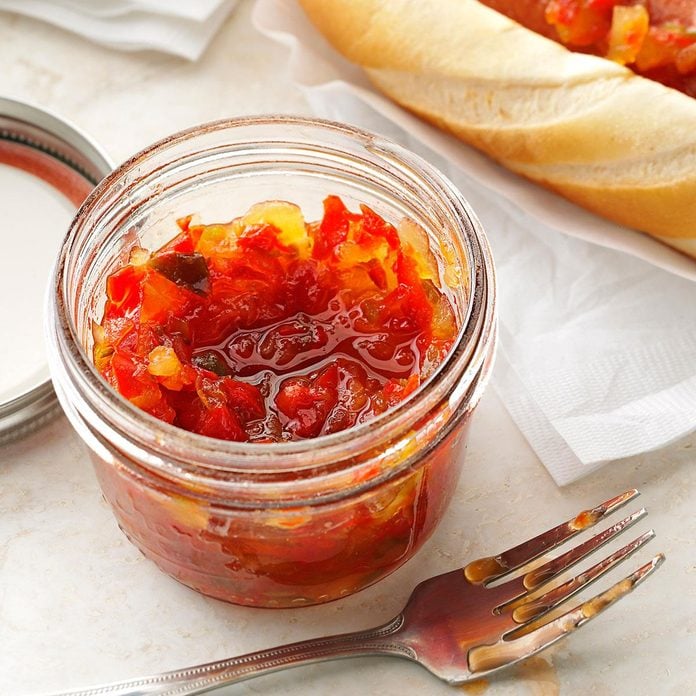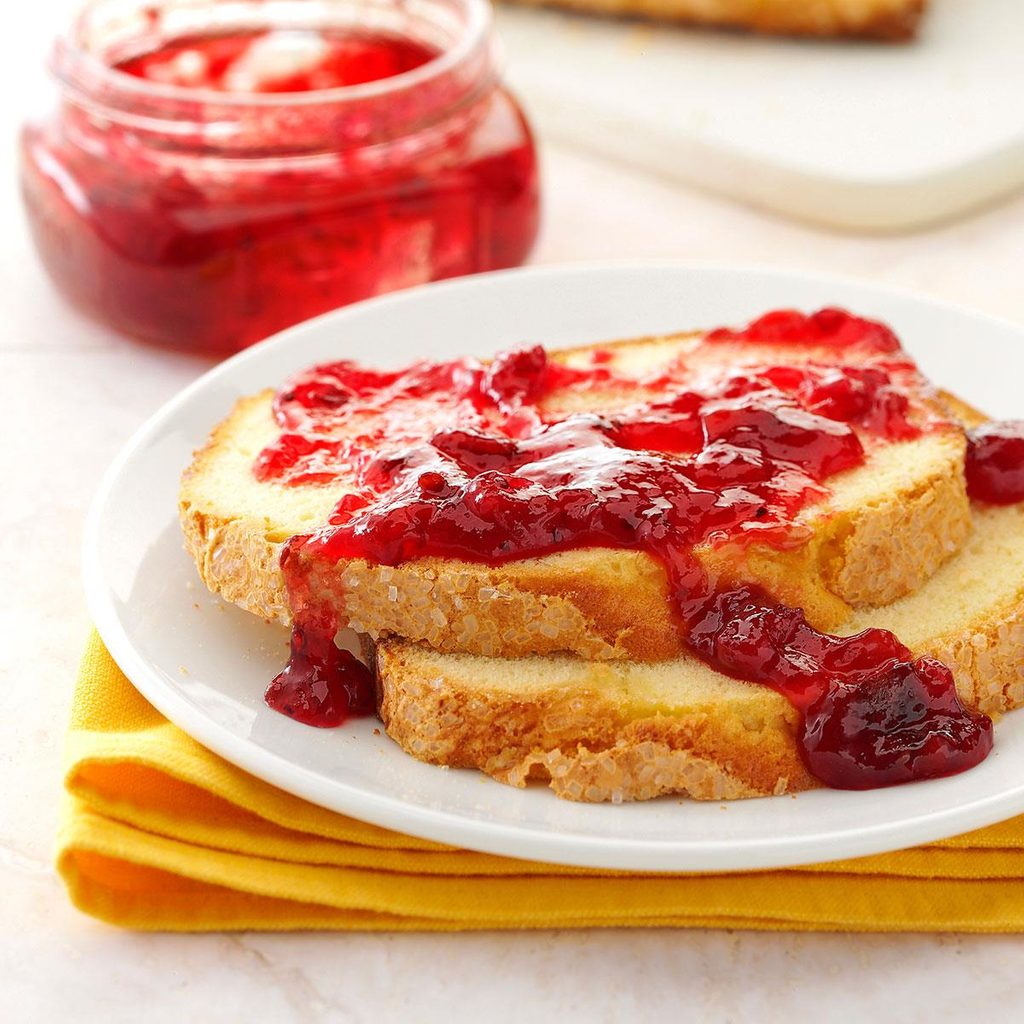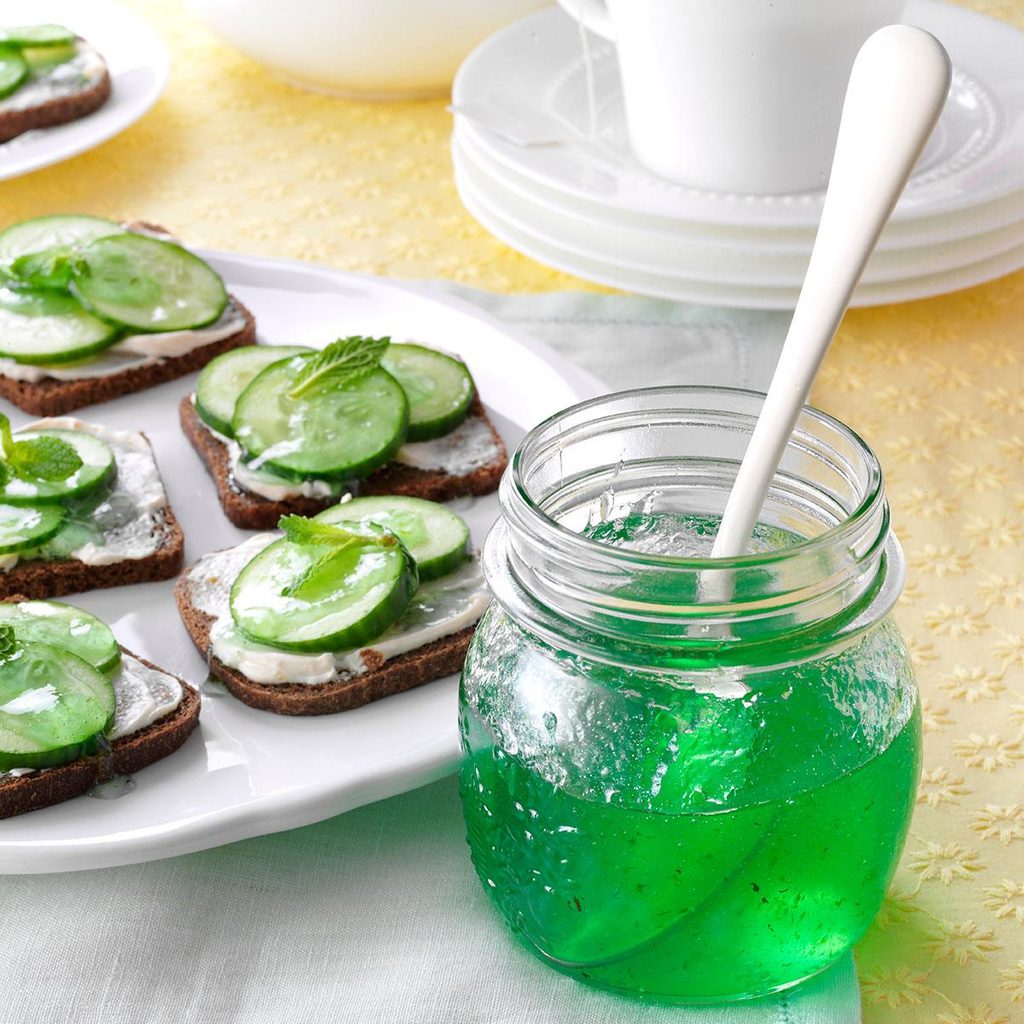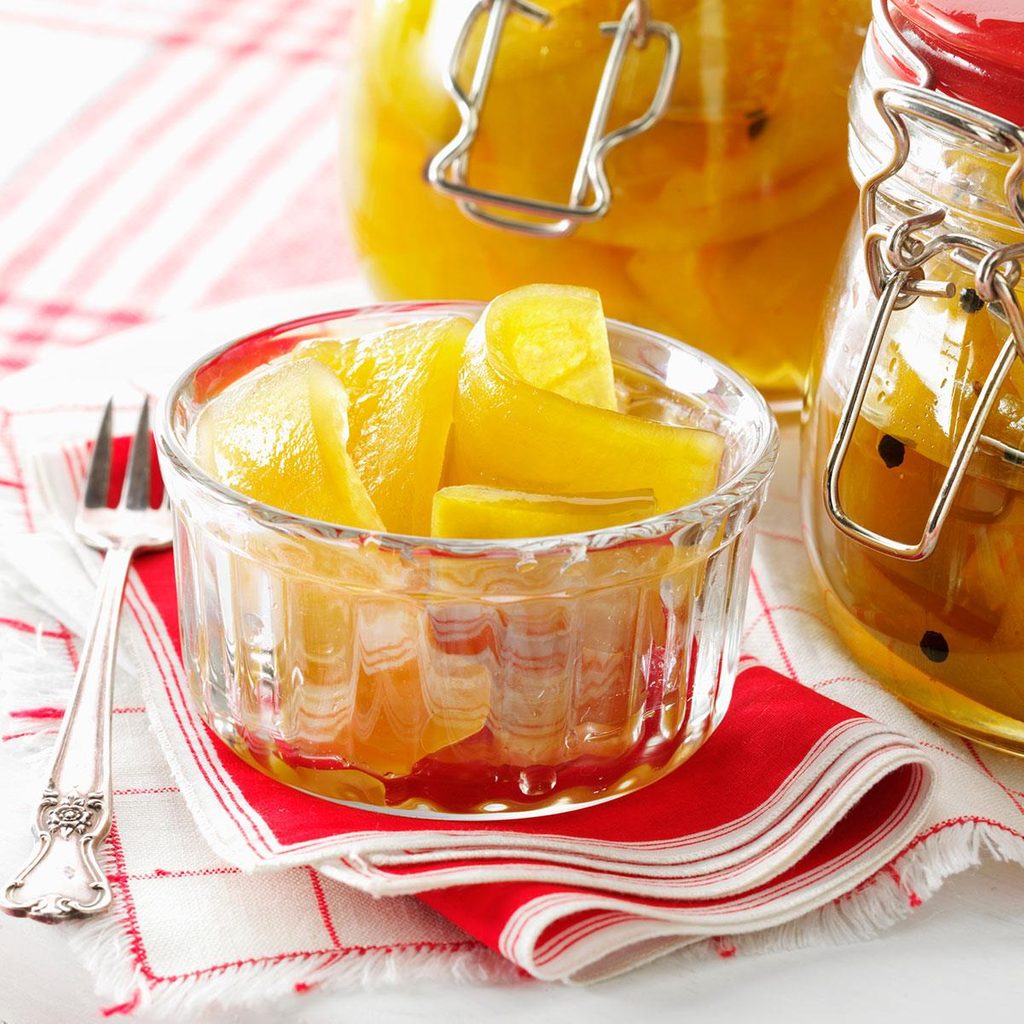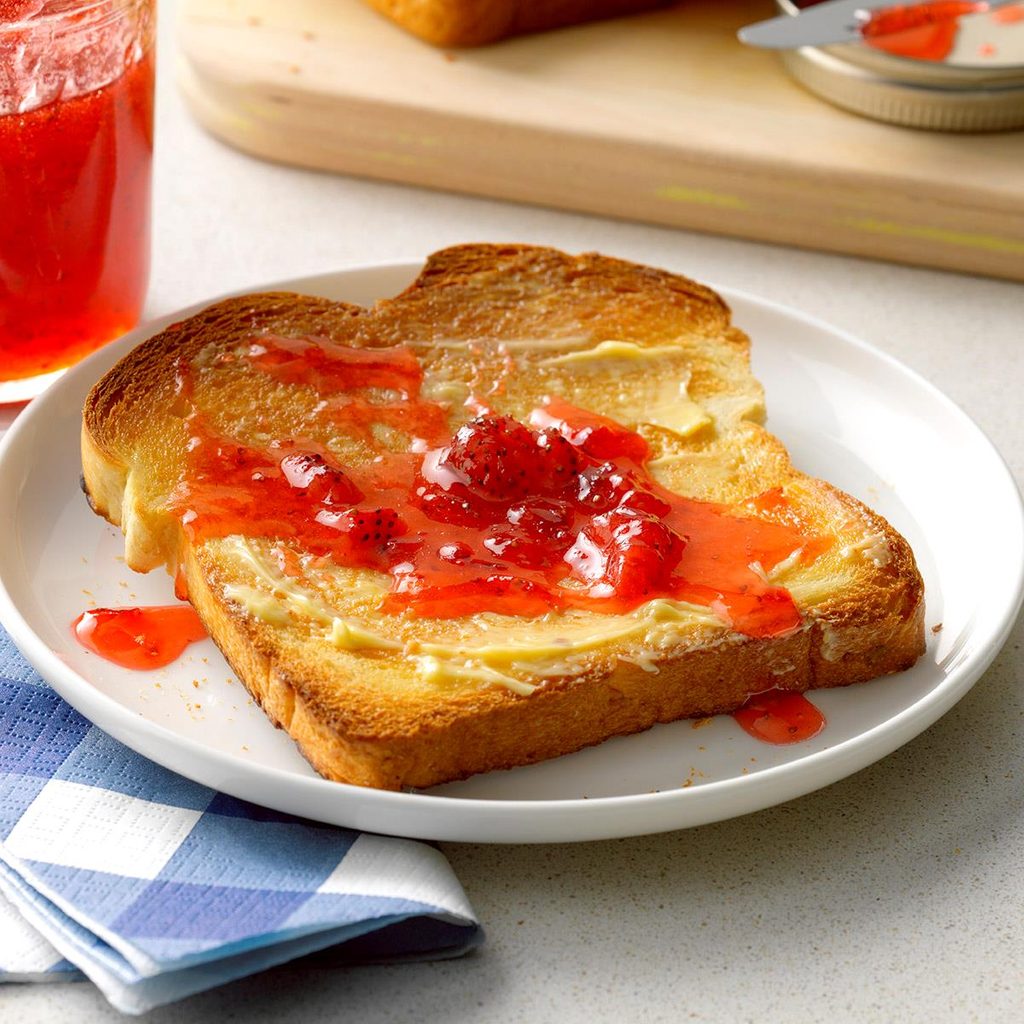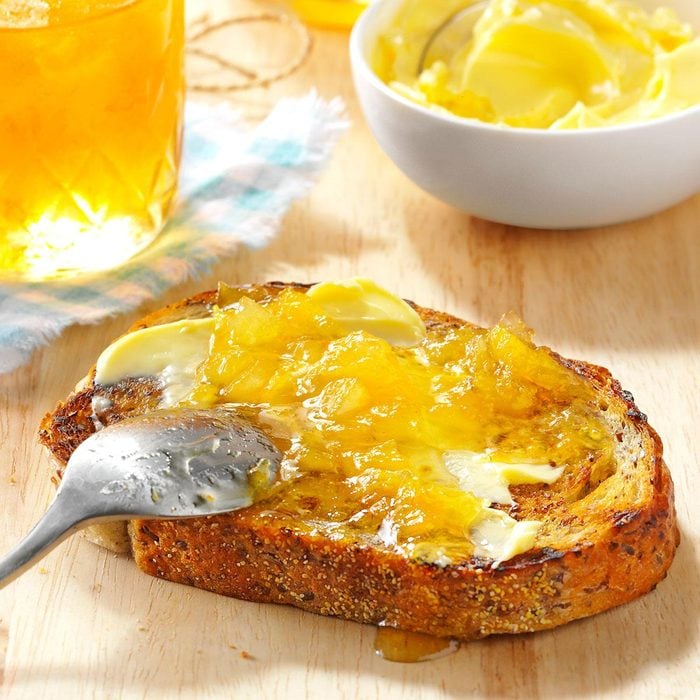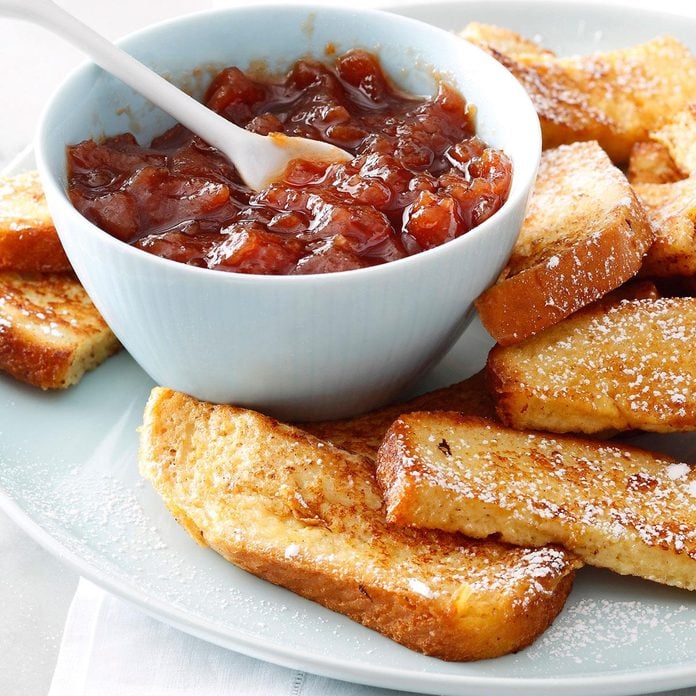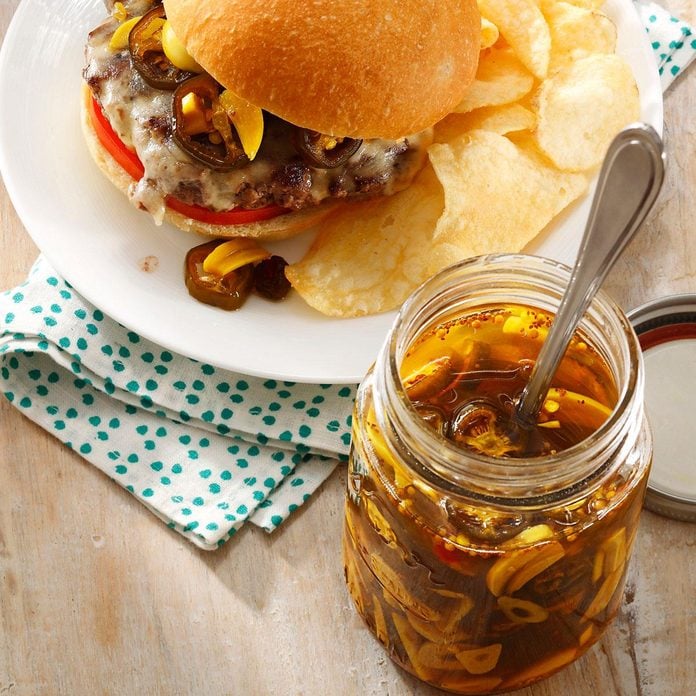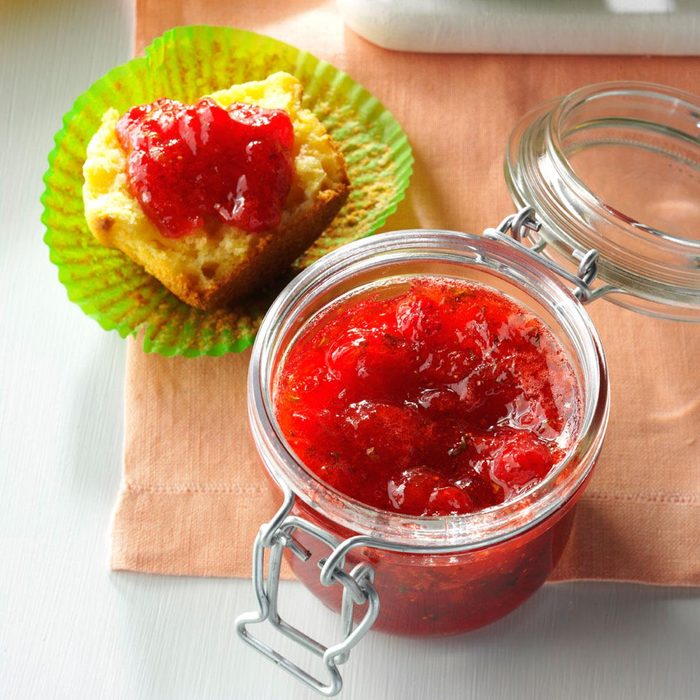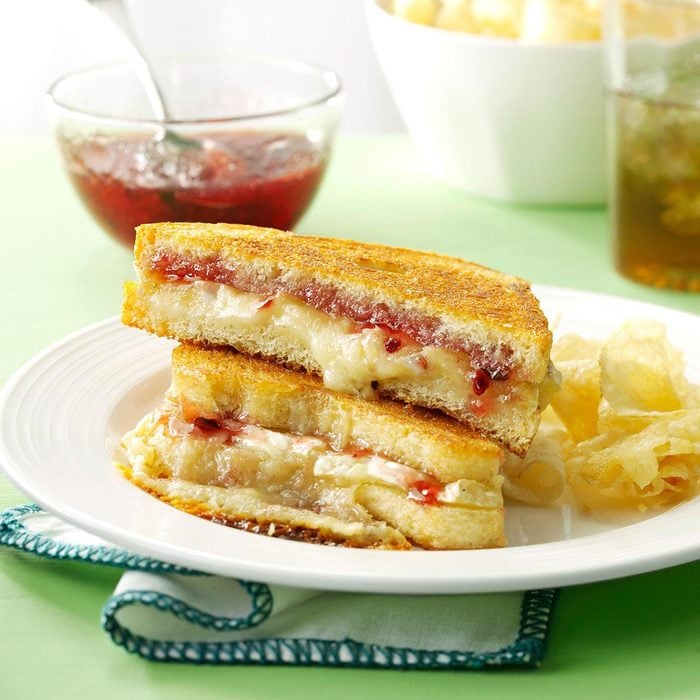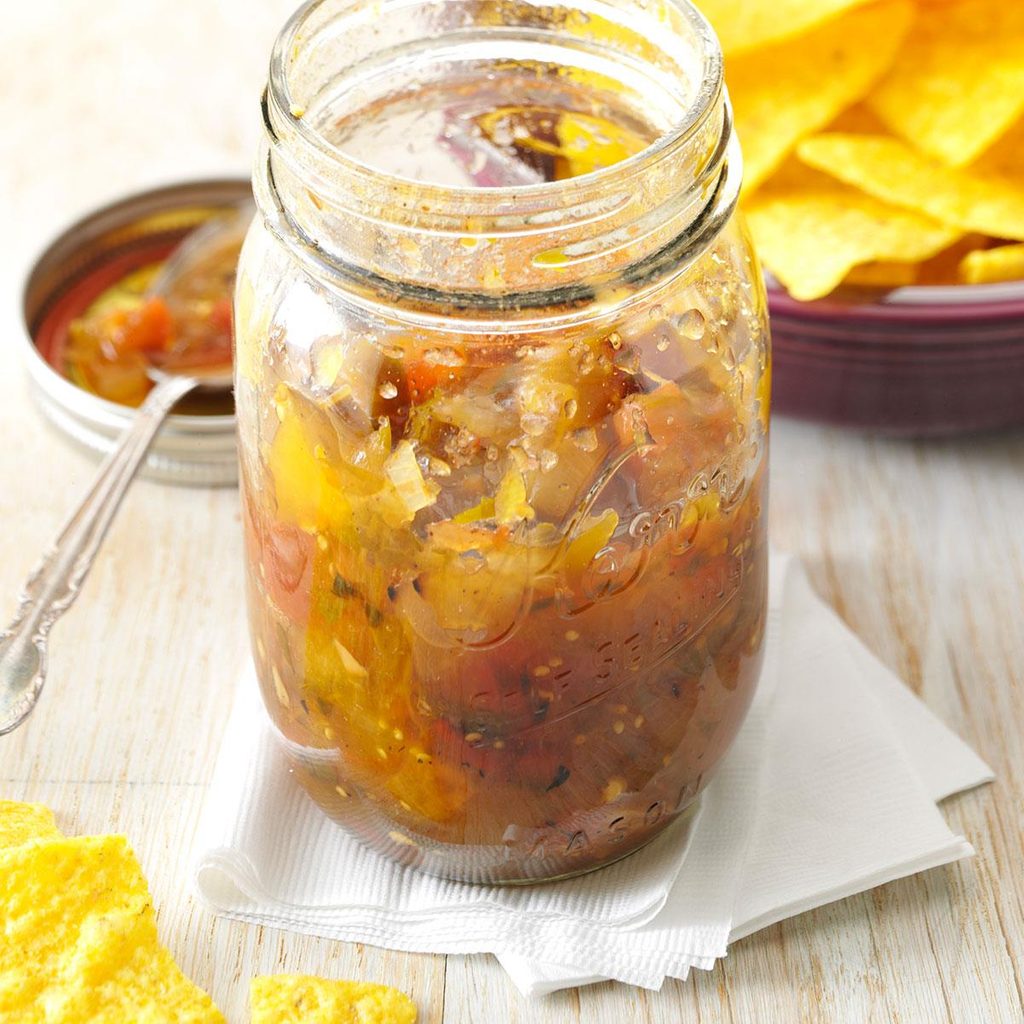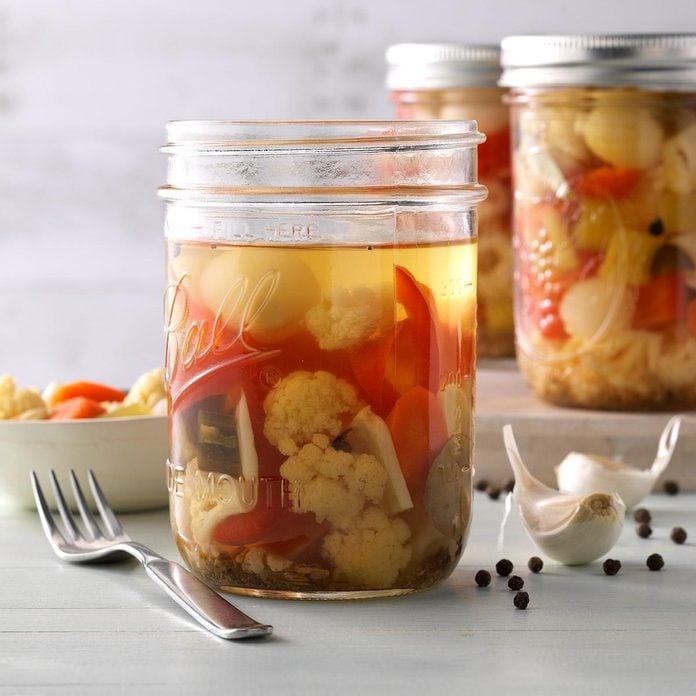Favorite Bread & Butter PicklesI made these pickles while growing up and love them because you can eat them with just about anything. Now, both of my children love these pickles too. I think you'll enjoy them as much as we do! —Linda Weger, Robinson, Illinois
Homemade Canned Spaghetti SauceDIY canning spaghetti sauce recipes are a tomato grower's dream come true! Use up your garden bounty and enjoy it later in the year. —Tonya Branham, Mt. Olive, Alabama
Raspberry Peach JamWhen my jam won a first-place pink ribbon at our local county fair, I was overjoyed but it's not the highest compliment that recipe has received. Two girlfriends that I share it with tell me if they don't hide the jam from their husbands and children, they'll devour an entire jarful at just a sitting! —Patricia Larsen, Leslieville, Alberta
Rhubarb JellyI help help my husband with the pouring and skimming for this jelly—my own personal favorite. It's nice as both a breakfast spread and a topping for pork or other meat. —Jean Coleman, Ottawa, Ontario
Ginger Pear Freezer JamAt dinner with friends one evening, one of our hosts served some pears she had preserved with ginger and lemon. The flavor was so heavenly I decided to use the fresh pears she gave us to try my hand at a ginger and lemon freezer jam.—Jeni Pittard, Commerce, Georgia
Yellow Summer Squash RelishMy friends can barely wait for the growing season to arrive so I can make this incredible squash relish. The color really dresses up a hot dog. —Ruth Hawkins, Jackson, Mississippi
Mild Tomato SalsaI got this salsa recipe from my sister, and my children and I have been making batches of it ever since. We pair pint jars with packages of tortilla chips for zesty Christmas gifts. When the kids give this present to their teachers, they can truthfully say they helped make it. —Pamela Lundstrum, Bird Island, Minnesota
Tomato Lemon MarmaladeThis is a marmalade I make for our church bazaar every fall. It always sells out in no time at all.—Mrs. Helen Witt, Minneapolis, Minnesota
Cinnamon Blueberry JamWatching my grandmother can hundreds of jars of tomatoes, peaches and pears inspired me to try making jams and jellies myself. I can remember going down into her cellar as a girl—all those jars on the shelves gave me such a warm, homey feeling! My family enjoys this jam on warm corn muffins, or blueberry. The cinnamon's a bit of a surprise. —Barbara Burns, Phillipsburg, New Jersey
Texas Jalapeno JellyA jar of this sweet and spicy jelly is always warmly appreciated. To add an extra southwestern accent, I trim the lid with a snappy bandanna print fabric. —Lori McMullen, Victoria, Texas
Spicy Chunky SalsaVinegar adds a refreshing tang to this sweet tomato salsa. It's wonderful as is, but for more heat, leave in some hot pepper seeds. —Donna Goutermont, Sequim, Washington
Rhubarb MarmaladeMy daughter makes this marmalade every spring when rhubarb's abundant. Our family enjoys her gift…a refreshing departure in flavor from all the berry jams and jellies. —Leo Nerbonne, Delta Juction, Alaska
Canned Blueberry JamSummer doesn't feel complete without at least one berry-picking trip and a batch of homemade blueberry jam. Eat atop fresh scones or biscuits for maximum enjoyment! —Marisa McClellan, Philadelphia, Pennsylvania
Refrigerator Jalapeno Dill PicklesI’m passionate about making pickles. My husband is passionate about eating them. He's too impatient to let them cure on the shelf, so I found this quick recipe to make him happy. Add hotter peppers if you like. —Annie Jensen, Roseau, Minnesota
Over-the-Top Cherry JamWe live in Door County, an area known for its wonderful tart cherries. This beautiful, sweet jam makes lovely gifts. —Karen Haen, Sturgeon Bay, Wisconsin
Pickled Green BeansThis recipe produces zippy little pickled green beans, preserving my veggies for months to come ... if they last that long. I crank up the heat a bit with cayenne pepper. —Marisa McClellan, Philadelphia, Pennsylvania
Tri-Berry JamMy mother-in-law and I dreamed up this jam after we'd been picking blueberries one day. She wondered if blueberries, raspberries and strawberries would taste good together. So she made a test batch—and we quickly learned that they definitely did! Then I came up with my own version of the jam. I preserve
everything from our garden! —Karen Maerkle, Baltic, Connecticut
Pickled Sweet PeppersI love to can my homegrown produce. I call this recipe Summer in a Jar. The peppers have a nice combination of tart and spicy flavors. —Edna Clemens, West Branch, Michigan
Chunky Peach SpreadHere's a fruit spread that captures the best tastes of late summer. I like that it's low in sugar and not overly sweet, which lets the fresh peach flavor shine right through. — Rebecca Baird, Salt Lake City, Utah
Sweet and Sour Zucchini PicklesPickled zucchini is a great way to use up all those green beauties in your garden. Preserve them now to share as a holiday gift from your kitchen. —Tina Butler, Royse City, Texas
Strawberry Basil JamI make this recipe with fresh-picked strawberries and basil grown in my own herb garden. This unique sweet and savory jam makes a perfect gift—just add a bright ribbon around the top with a gift tag! The deep red jam, laced with flecks of green basil, is so beautiful. —Julie O'Neil, Two Harbors, Minnesota
Pickled Sweet OnionsThese slightly crunchy pickled onions are not only a great gift for Christmas, but also a terrific contribution to a backyard barbecue as a relish for burgers and hot dogs. —Laura Winemiller, Delta, Pennsylvania
Spiced Cran-Apple and Grape ConserveFaced with an abundance of grapes from my garden, I wound up using them in various ways. This conserve was an afterthought, but I received so many great compliments from family and friends that I made sure to write down the recipe. I served it with crackers and Brie cheese, but it would be great with pork, chicken, ham and cheesecake, too. —Kallee Krong-McCreery, Escondido, California
Homemade Spicy Hot SauceI created this spicy recipe one day using what I had available from my garden: hot peppers, carrots, onions and garlic. The carrots make this recipe stand out. —Carolyn Wheel, Fairfax, Vermont
Spiced Cran-Apple and Grape ConserveFaced with an abundance of grapes from my garden, I wound up using them in various ways. This conserve was an afterthought, but I received so many great compliments from family and friends that I made sure to write down the recipe. I served it with crackers and Brie cheese, but it would be great with pork, chicken, ham and cheesecake, too. —Kallee Krong-McCreery, Escondido, California
Homemade Spicy Hot SauceI created this spicy recipe one day using what I had available from my garden: hot peppers, carrots, onions and garlic. The carrots make this recipe stand out. —Carolyn Wheel, Fairfax, Vermont
Strawberry Basil JamI make this recipe with fresh-picked strawberries and basil grown in my own herb garden. This unique sweet and savory jam makes a perfect gift—just add a bright ribbon around the top with a gift tag! The deep red jam, laced with flecks of green basil, is so beautiful. —Julie O'Neil, Two Harbors, Minnesota
Honey Blueberry Cobbler JamI work at a farmers market, and honey blueberry jam is my top seller. You've gotta taste it with fresh goat cheese and toasted candied pecans. —Krystal Wertman, Humble, Texas
Strawberry Basil JamI make this recipe with fresh-picked strawberries and basil grown in my own herb garden. This unique sweet and savory jam makes a perfect gift—just add a bright ribbon around the top with a gift tag! The deep red jam, laced with flecks of green basil, is so beautiful. —Julie O'Neil, Two Harbors, Minnesota
Honey Blueberry Cobbler JamI work at a farmers market, and honey blueberry jam is my top seller. You've gotta taste it with fresh goat cheese and toasted candied pecans. —Krystal Wertman, Humble, Texas
Sweet-Hot Asian Dipping SauceThis Asian-inspired sauce is a delicious egg roll dipping sauce, but it can also be used for veggies or to make a sweet-tangy vinaigrette. —Taste of Home Test Kitchen, Milwaukee, Wisconsin
Tomatillo RelishI have a very hearty tomatillo plant in my garden. To use up the abundant produce, I decided to make a relish. You can use it as a dip or as a condiment on eggs, hot dogs, meat loaf or burgers. It has an addictive taste. —Deb LaBosco, Foley, Minnesota
Cider JellyFor a tasty jam during the fall, try this cider. The candy adds a wonderful cinnamon flavor.—Donna Bensend, Dallas, Wisconsin
Peach-Blueberry PreservesAs a child I helped my grandmother can summer fruits and vegetables. I didn't always appreciate this activity when I was young, but now I miss her terribly and wish we could have another summer afternoon in her kitchen. I think she would enjoy this recipe. —Katie Ferrier Gage, Houston, Texas
Rhubarb-Cherry ChutneyI love surprising recipes like this chutney with rhubarb, apple and cherries. Try it with cream cheese and crackers or as a condiment for grilled chicken. —Sue Gronholz, Beaver Dam, Wisconsin
Slow-Cooked Peach SalsaFresh peaches and tomatoes make my salsa a winner over store-bought versions. As a treat, I give my coworkers several jars throughout the year. —Peggi Stahnke, Cleveland, Ohio
Rosemary JellyThis deliciously different green jelly gets its flavor from an unusual source: savory rosemary. The herb adds a refreshing zip to the otherwise sweet spread. —Margaret Dumire, Carroll, Ohio
Easy Apricot JamHere’s the perfect topping for English muffins or toast. It’s so simple to make my homemade jam, you’ll want to share it with all your friends. —Geri Davis, Prescott, Arizona
Honey Lemon JellyI love both honey and lemon, so I combined those ingredients into a doubly delightful jelly. Spread it on toast, bagels, English muffins or scones for a tangy breakfast treat. —Ramona Wysong, Barlow, Kentucky
Bill's Apple ButterSince retiring, I have more time to tend to our 75 apple trees and to experiment in the kitchen. I came up with this old-fashioned apple butter after some trial and error. The red-hot candies make it unique.—Bill Elliott, Urbana, Missouri
Chunky Cherry & Peach PreservesOut of all the jams I make, this is my grandmother’s favorite. She anxiously waits for late June to come because she knows I’ll put up as many batches as I can while peaches and cherries are at their peak. —Amy Seiger, McLoud, Oklahoma
Sweet & Spicy Pickled Red Seedless GrapesMost people don't think about grapes when creating a canned pickle recipe. The pickling liquid for these grapes includes red wine, vinegar and common pickling spices like coriander, mustard seeds and hot pepper; it also contains warm spices like cinnamon and star anise along with brown sugar. These flavor-packed grapes are unique and delicious on a fab antipasto, pickle or cheese tray. —Cheryl Perry, Hertford, North Carolina
Autumn Pepper RelishThis colorful relish is a favorite with friends and family because it tastes amazing on just about everything. I like to serve it over cream cheese or a block of sharp cheddar cheese along with crackers or French baguette slices. I also include a jar in gift baskets. —Barbara Pletzke, Herndon, Virginia
Plum Anise JamGrowing up, my father loved black licorice and all my siblings and I loved it as well. I still love the flavor of black licorice but can't eat the candy anymore for health reasons. This recipe reminds me of the flavor I loved as a child. The delicious jam tastes great with Brie or goat cheese and crackers. —Jill Grueninger, Mequon, Wisconsin
Lime Mint JellyThis holly-green jelly won a Best of Show at the county fair and I was so thrilled. Flavored with lime, it's delicious on roasted meats. —Gloria Jarrett, Loveland, Ohio
Watermelon Rind Pickles"Waste not, want not" has always been smart advice—especially when it produces picked watermelon rind that's so refreshing. —Taste of Home Test Kitchen
Quick and Easy Strawberry JamThis is an easy and tasty way to use up a freshly picked quarts of summer strawberries. It makes about seven half-pints, so there's enough to share. —Ball Brand and Kerr Brand home canning products
Three-Fruit MarmaladeI make all my own jams, and this marmalade is a favorite. It marries the warm flavors of peaches and pears with citrus. —Lorraine Wright, Grand Forks, British Columbia
Pear PreservesIn the fall we would go to our farm and pick pears and apples. Then we'd build a campfire and roast hot dogs. Later we'd all get together and make big batches of these tasty preserves. —Tammy Watkins, Greentop, Missouri
Cowboy Candy (Candied Jalapenos)If you love spicy food like we do, then these tasty candied jalapenos—also known as cowboy candy—are for you! You can save the syrup to baste roasted chicken or grilled salmon, or mix it into salad dressings. Jars of this dynamite condiment make a great gift. —Rita Ladany, Edison, New Jersey
Berry-Basil Limeade JamMy husband and I have fun picking fruit. We ended up with too many strawberries, so it was time to make jam, inspired by a mojito recipe. —Erica Ingram, Lakewood, Ohio
Double-Berry Jalapeno JamMy friend and I had tried a fruity jam with jalapenos at a local vineyard and this is the version I created. I like this spread on crackers with cream cheese, on hamburgers or even on grilled cheese. For extra heat, add the seeds of a few jalapenos to the jam. —Lisa Keim, Watertown, New York
Sweet & Smoky SalsaI love the roasted flavor that grilling gives food, so I decided to make a salsa from grilled vegetables. I think this recipe would also taste great using plum tomatoes. Also, if you can't use wood chip charcoal, you might try adding a little liquid smoke to the salsa while it cooks. —Shelly Bevington, Hermiston, Oregon
GiardinieraSweet and tangy, this Italian condiment is packed with peppers, cauliflower, carrots and other crisp-tender veggies. It’s perfect to offer alongside pickles or olives on a relish tray. —Taste of Home Test Kitchen, Milwaukee, Wisconsin
